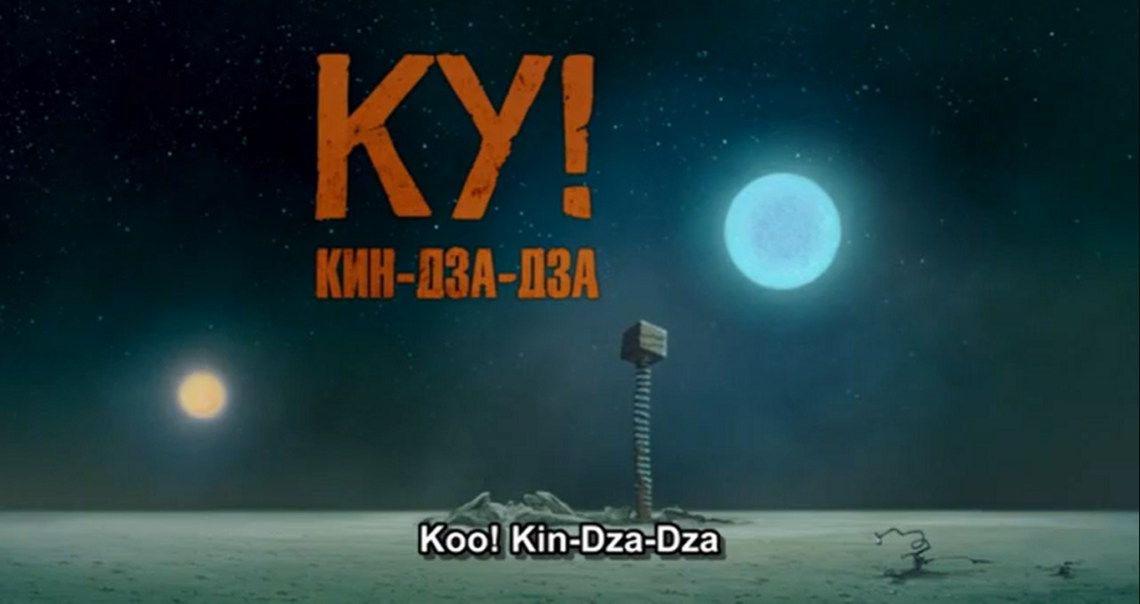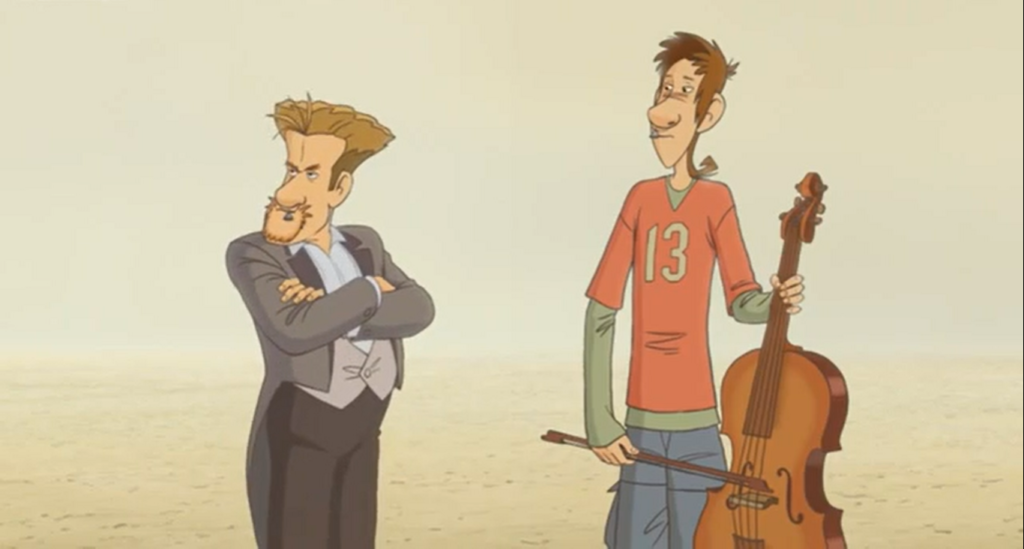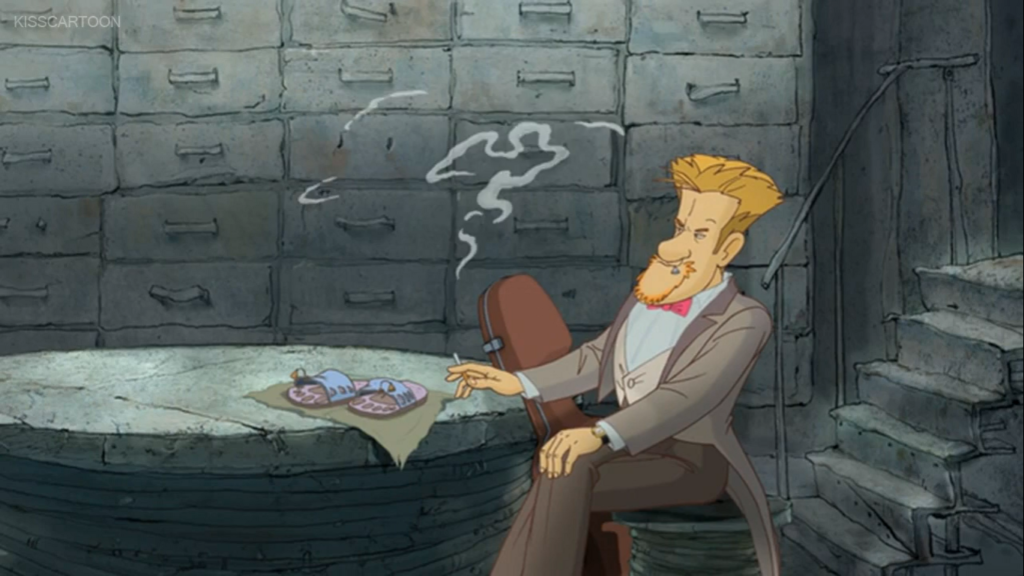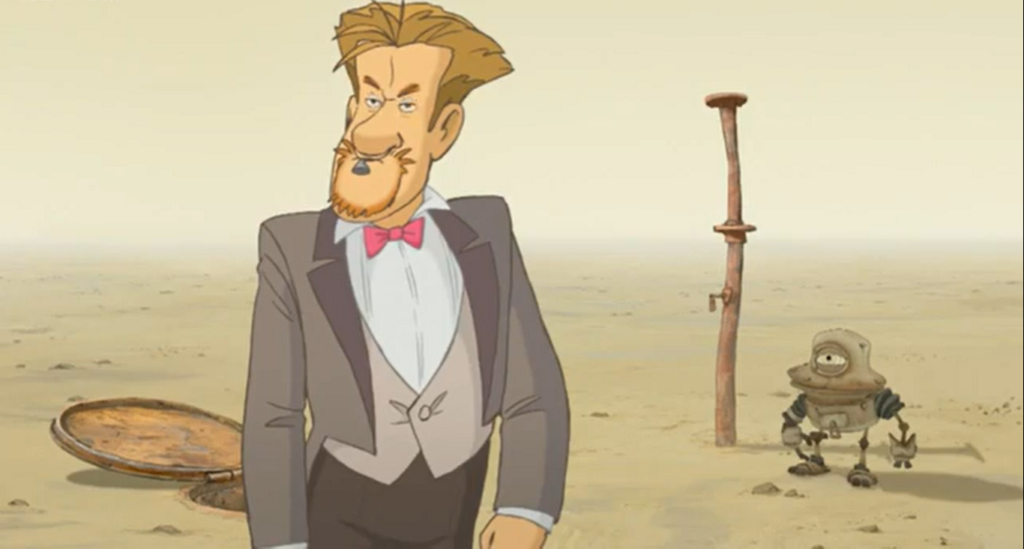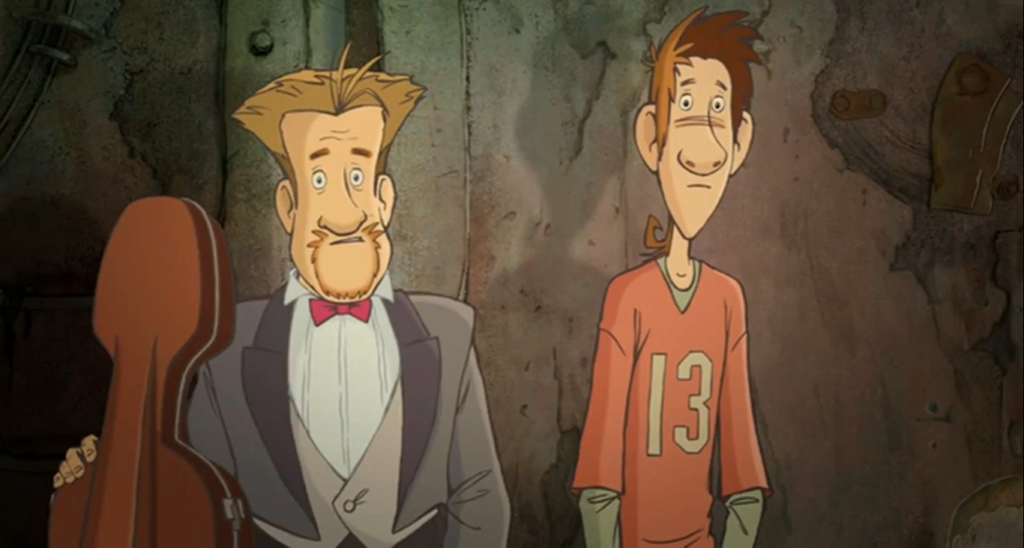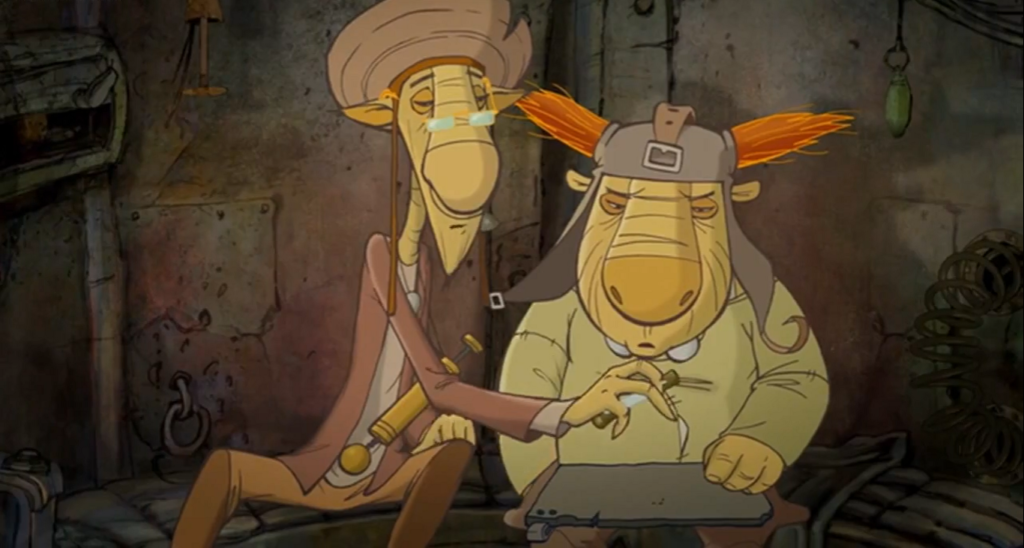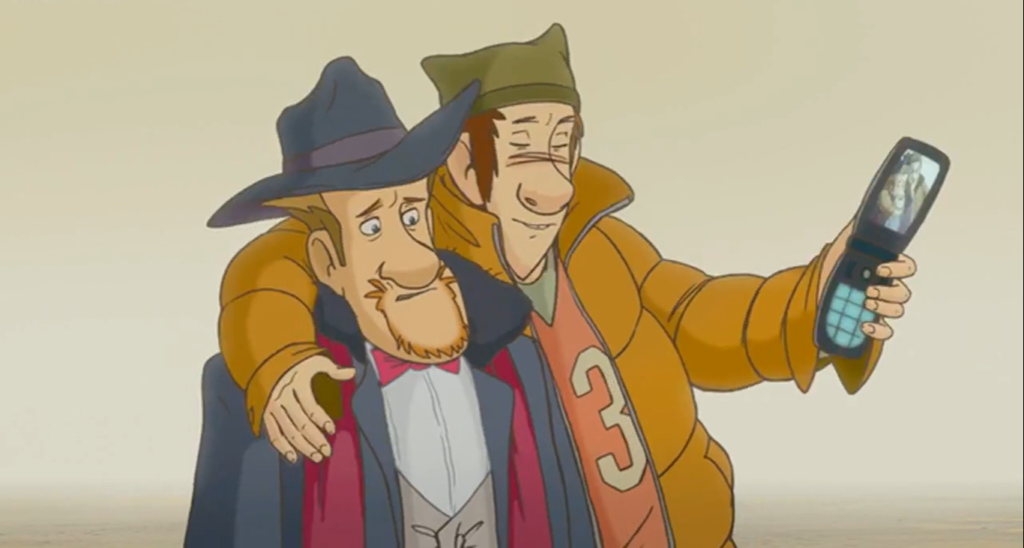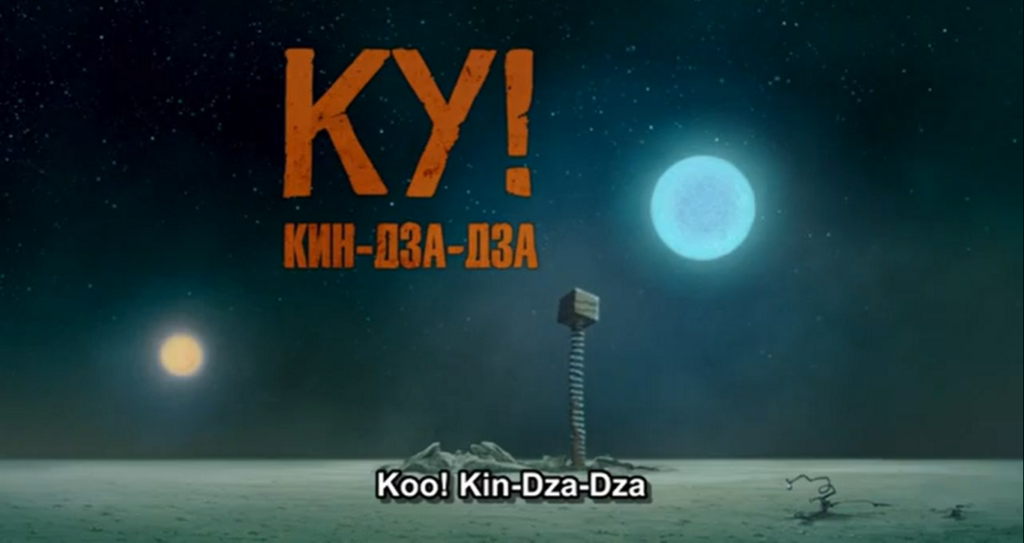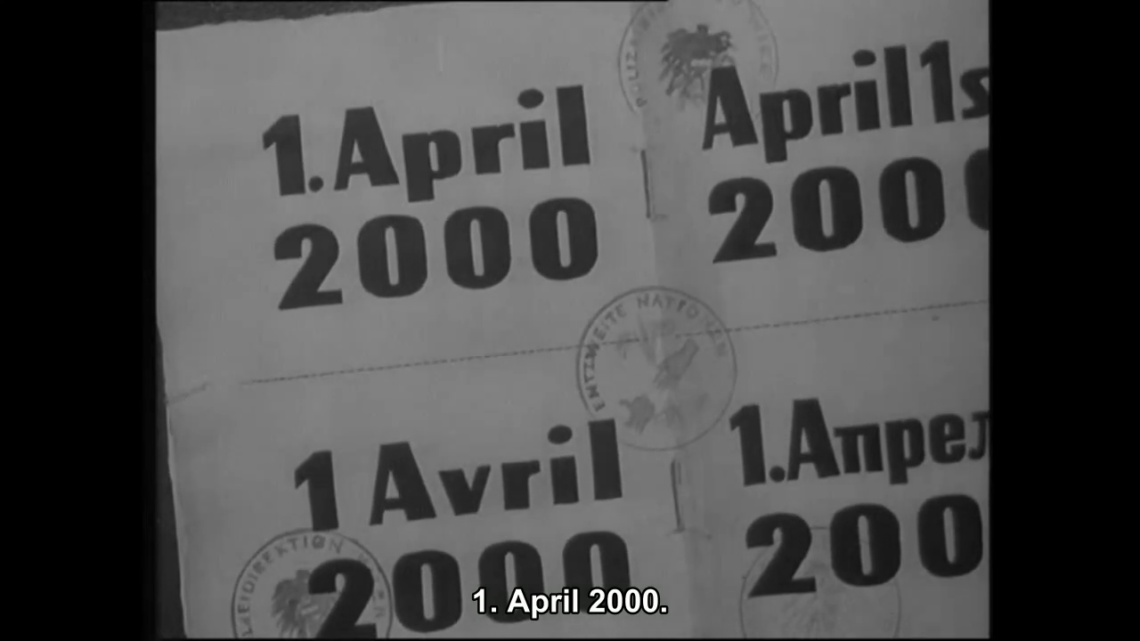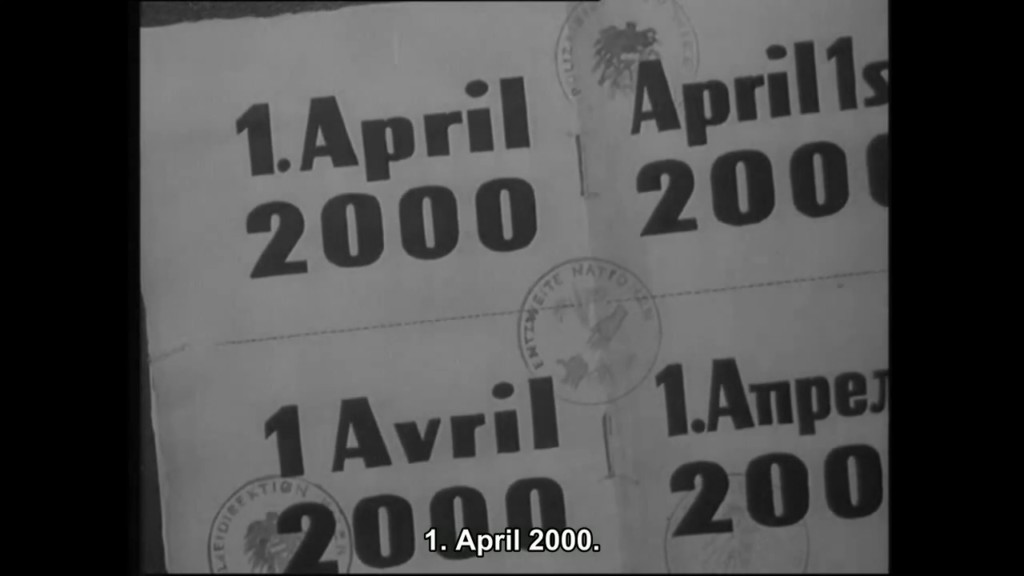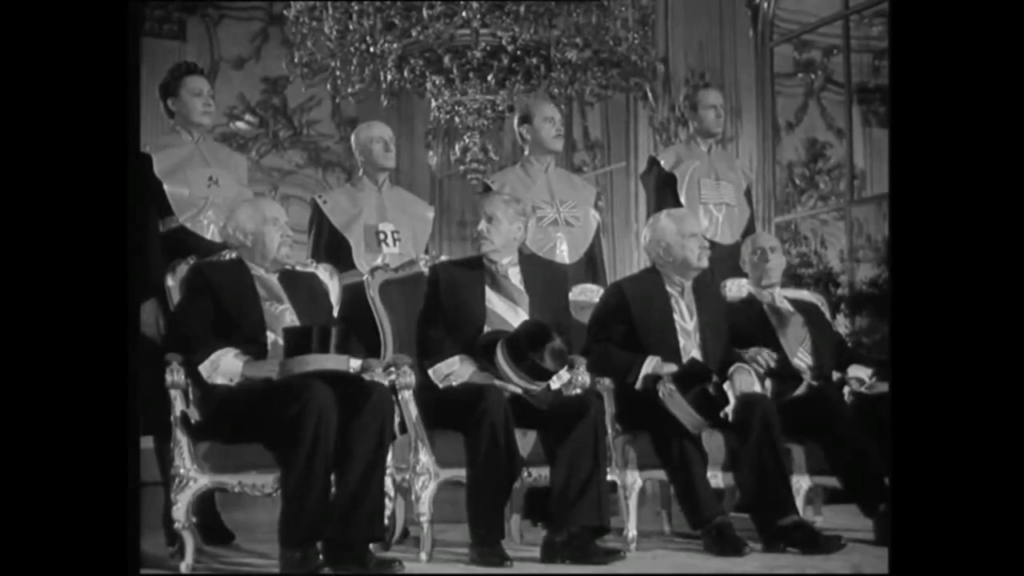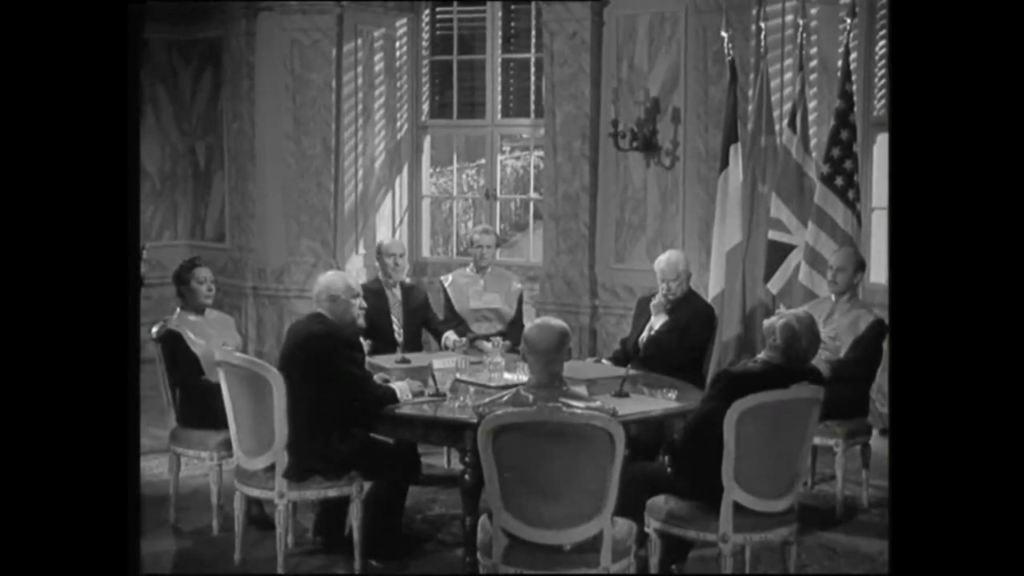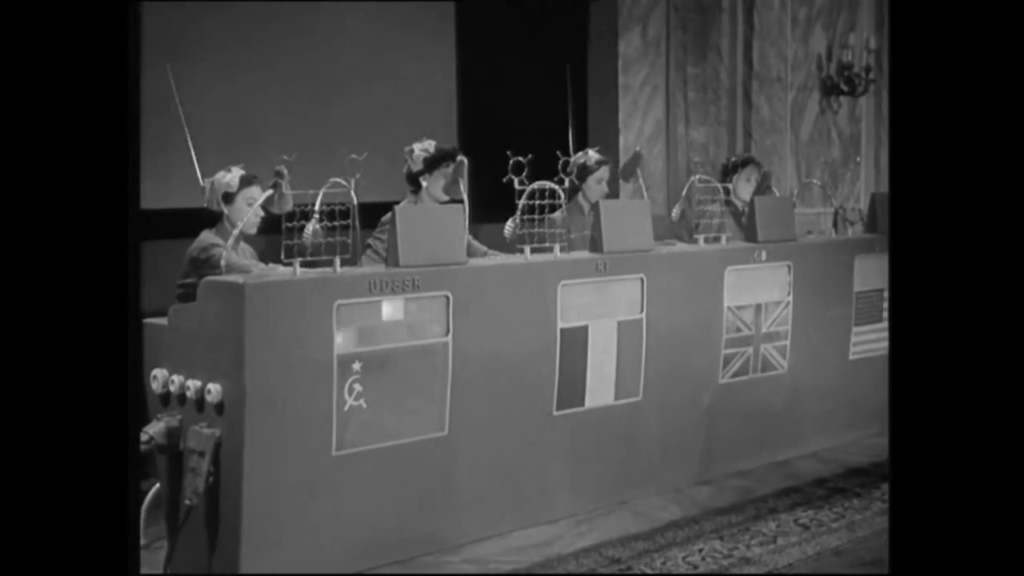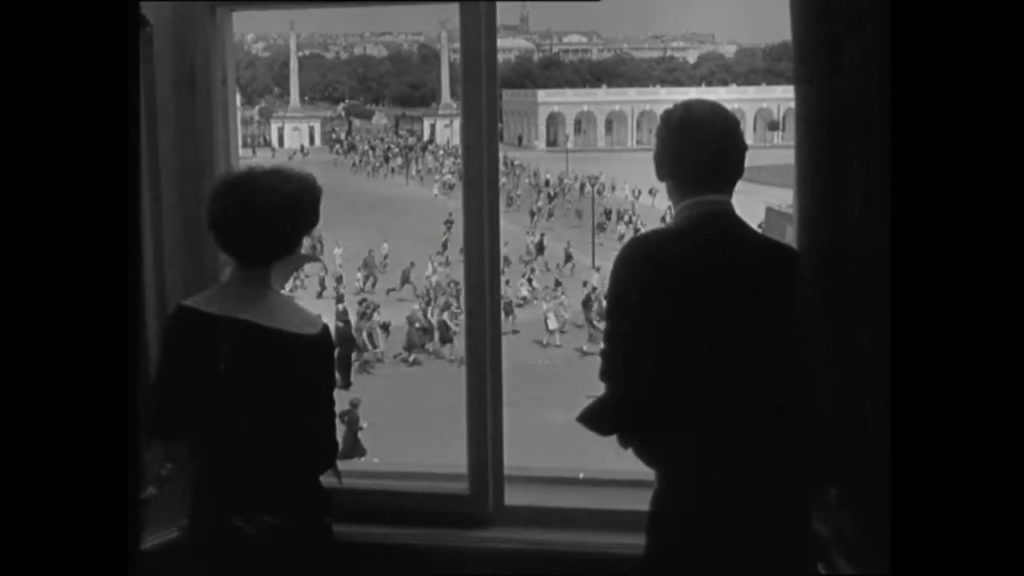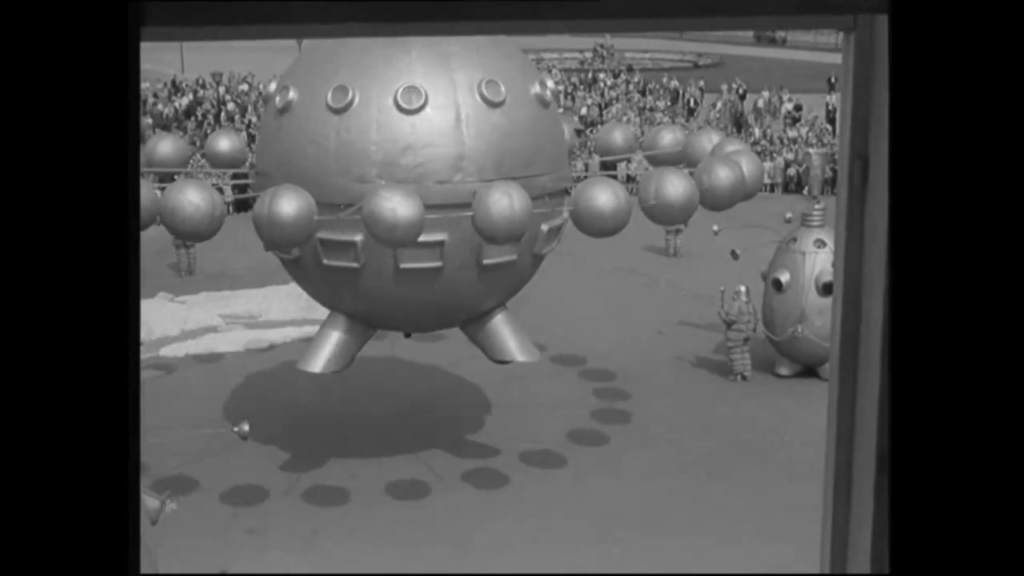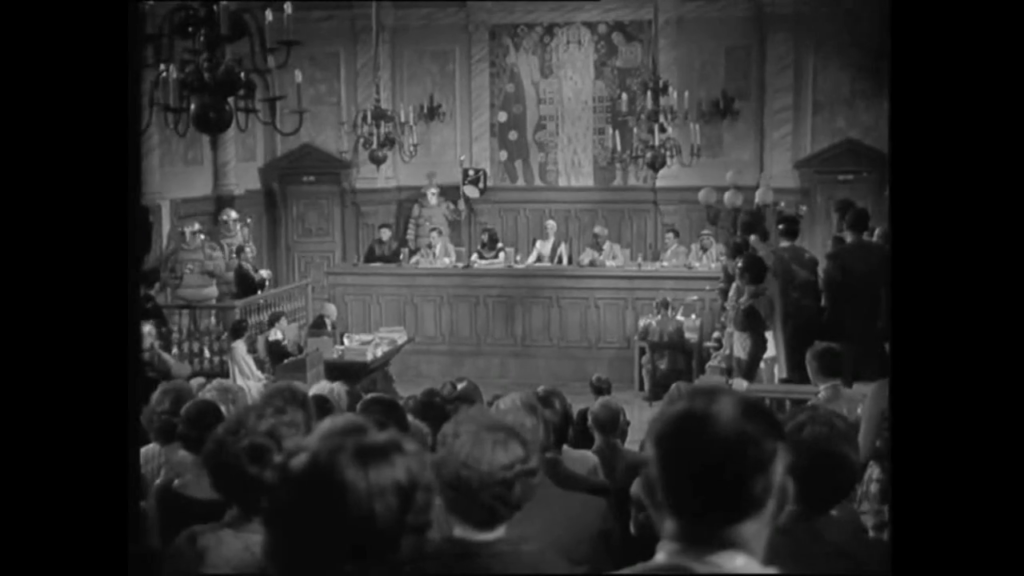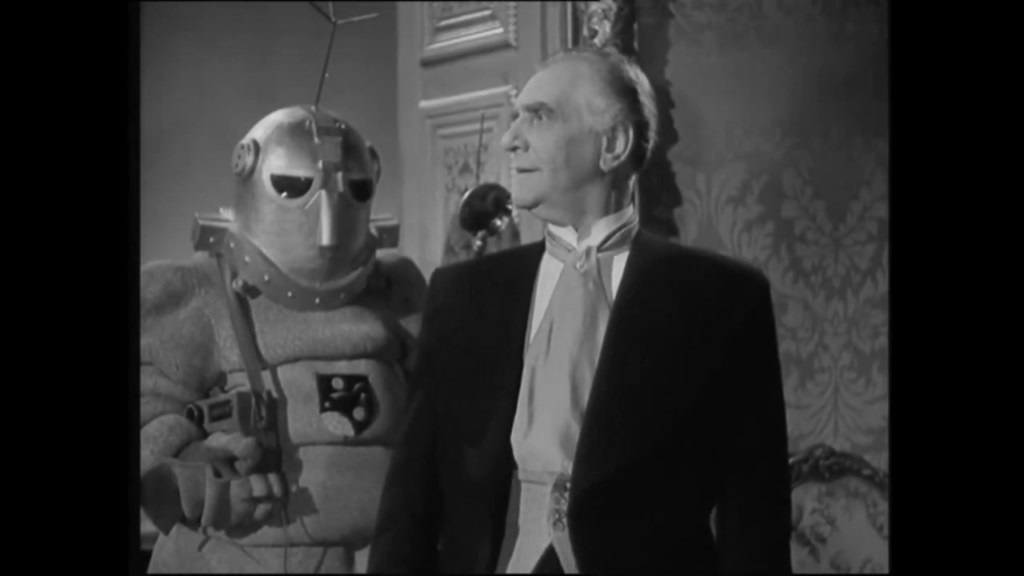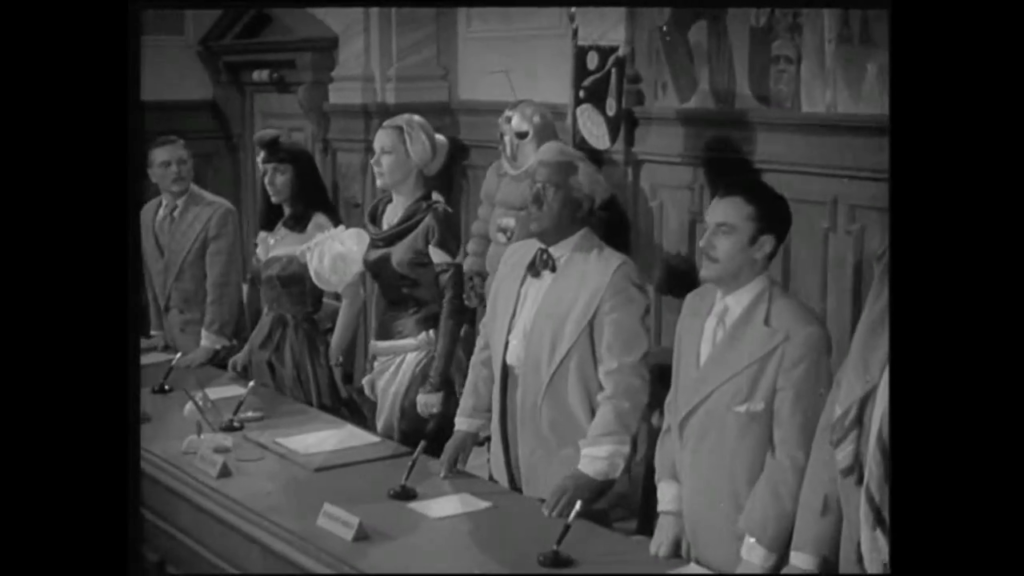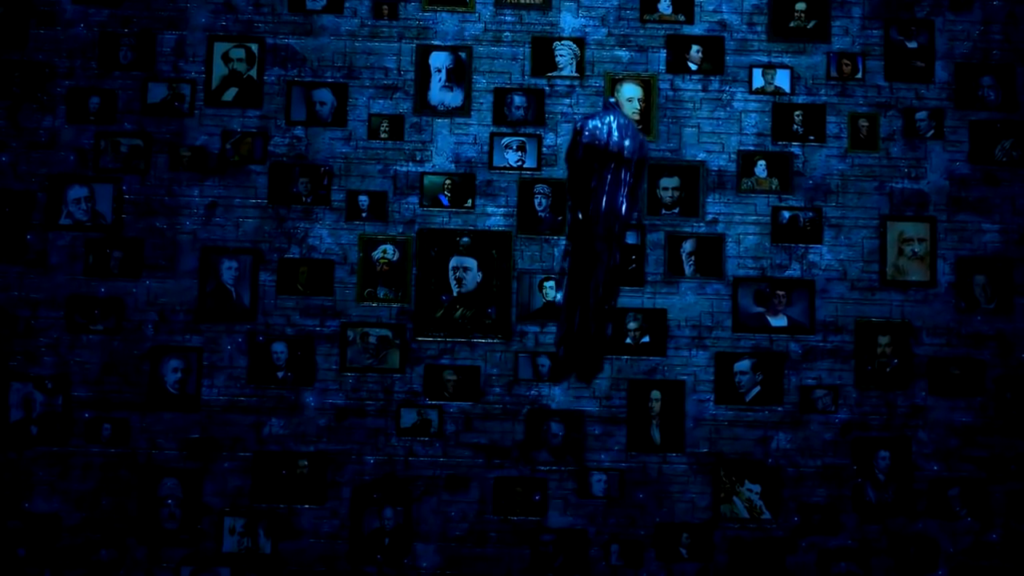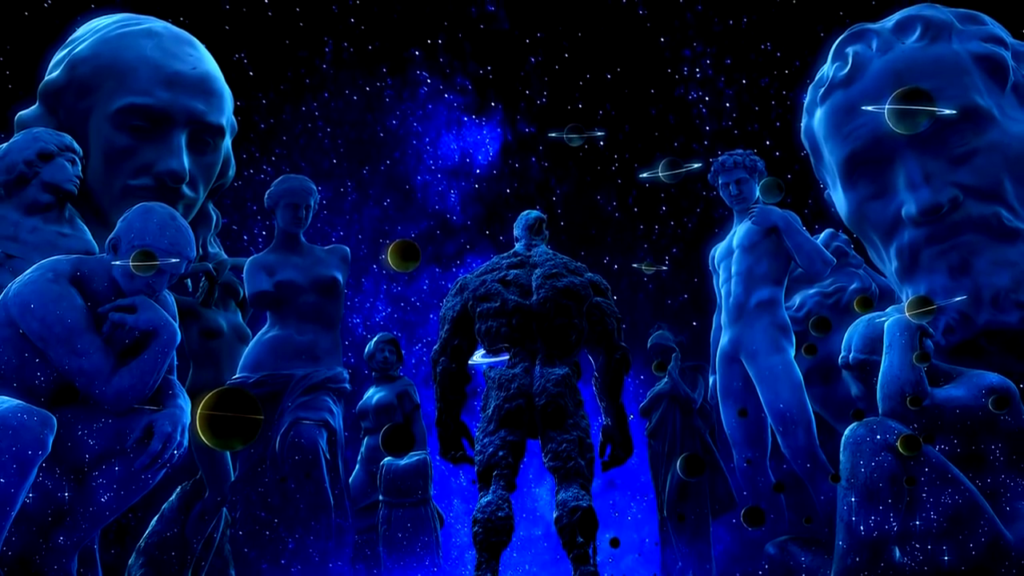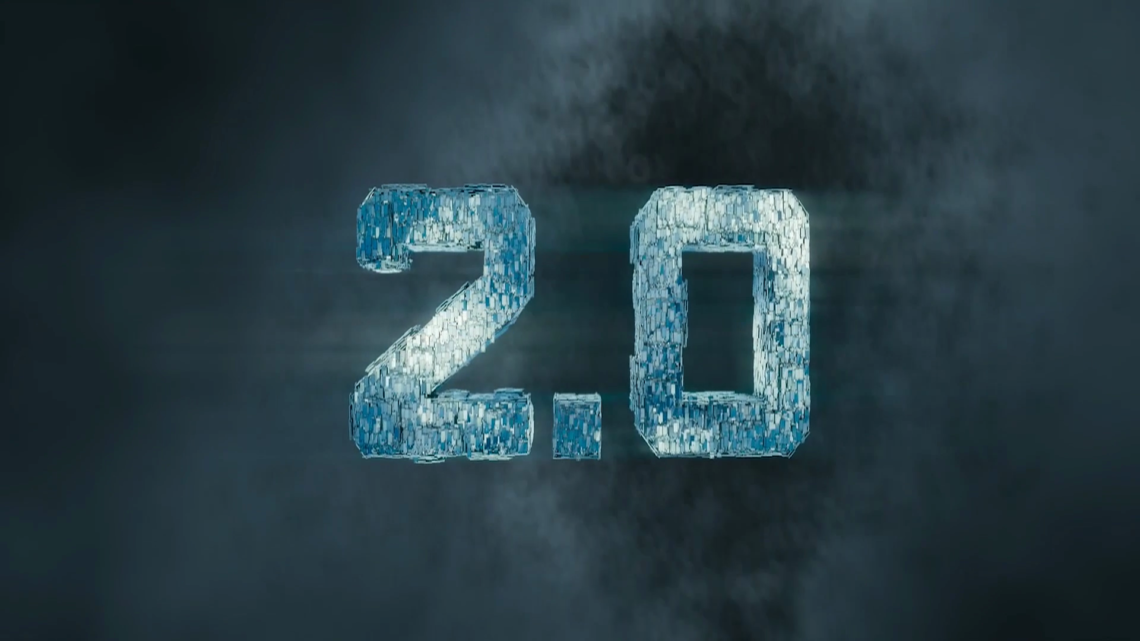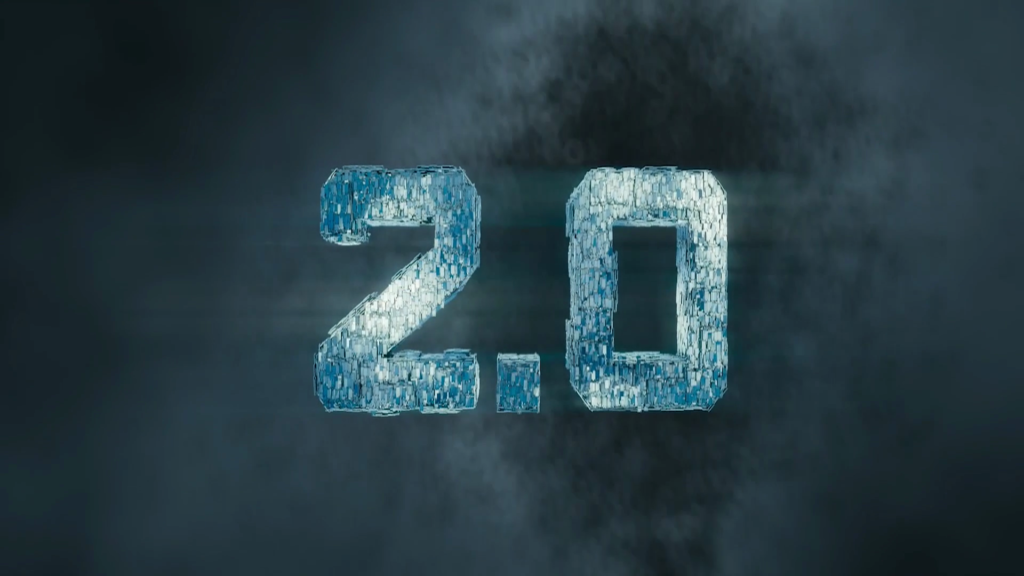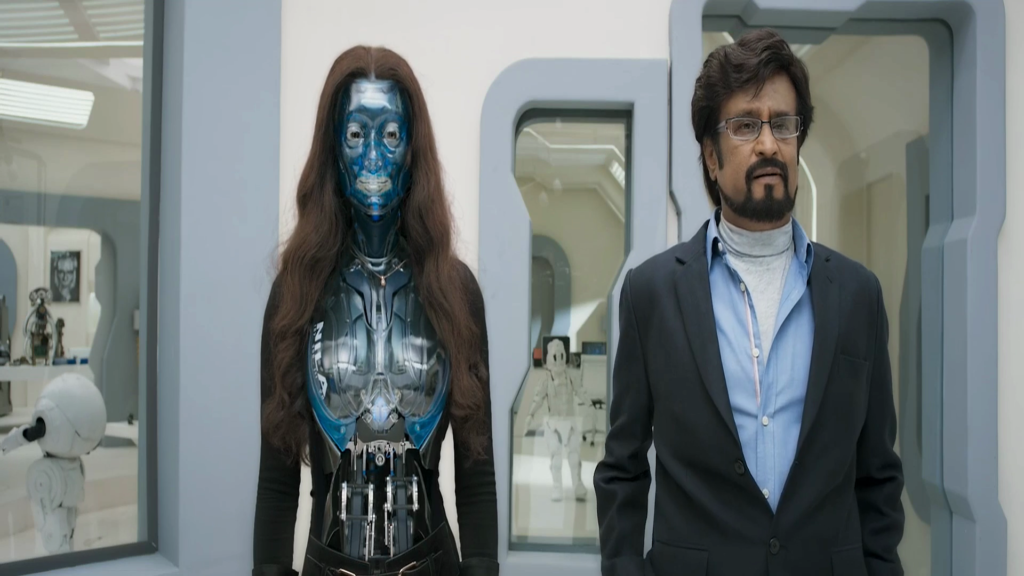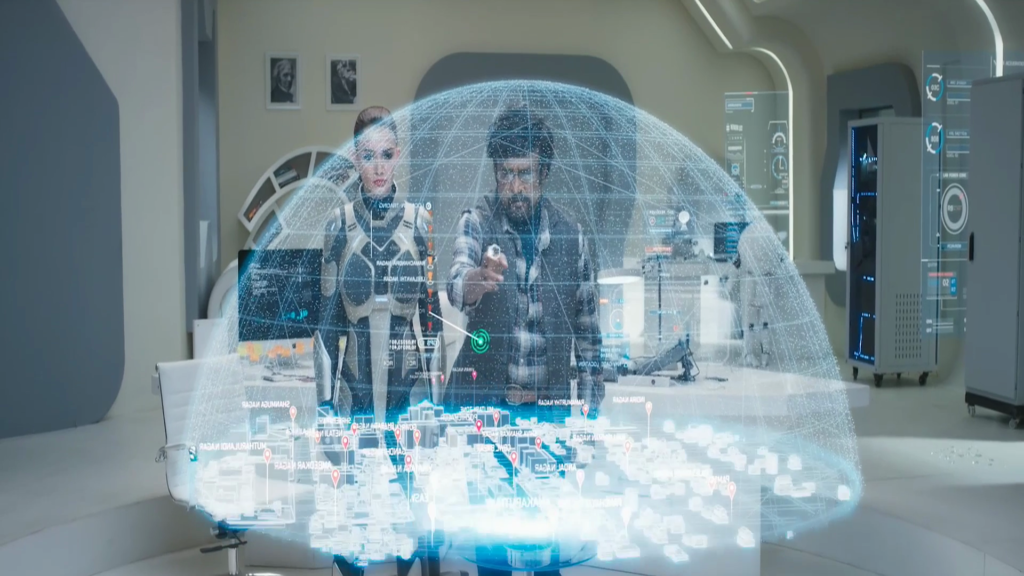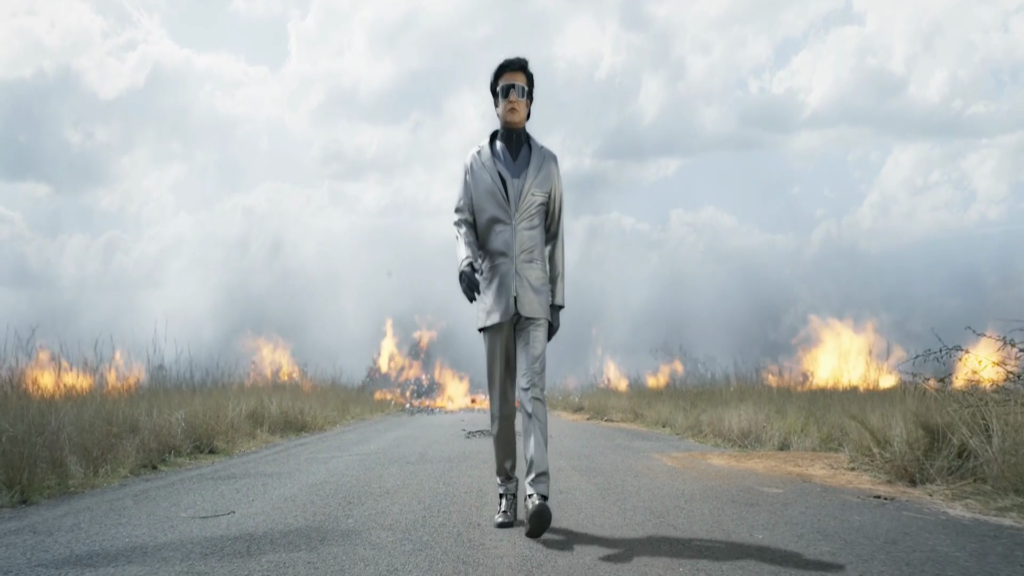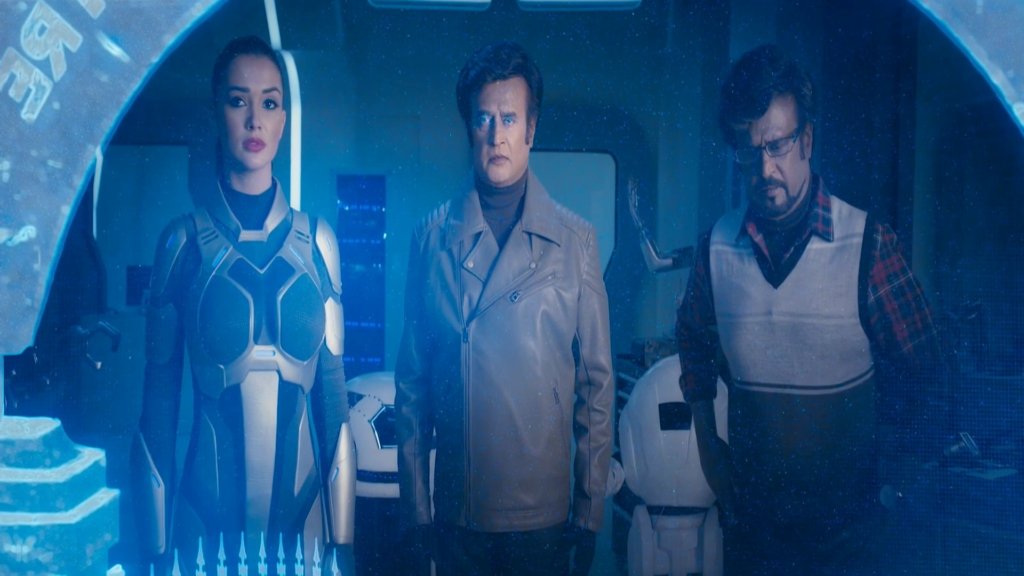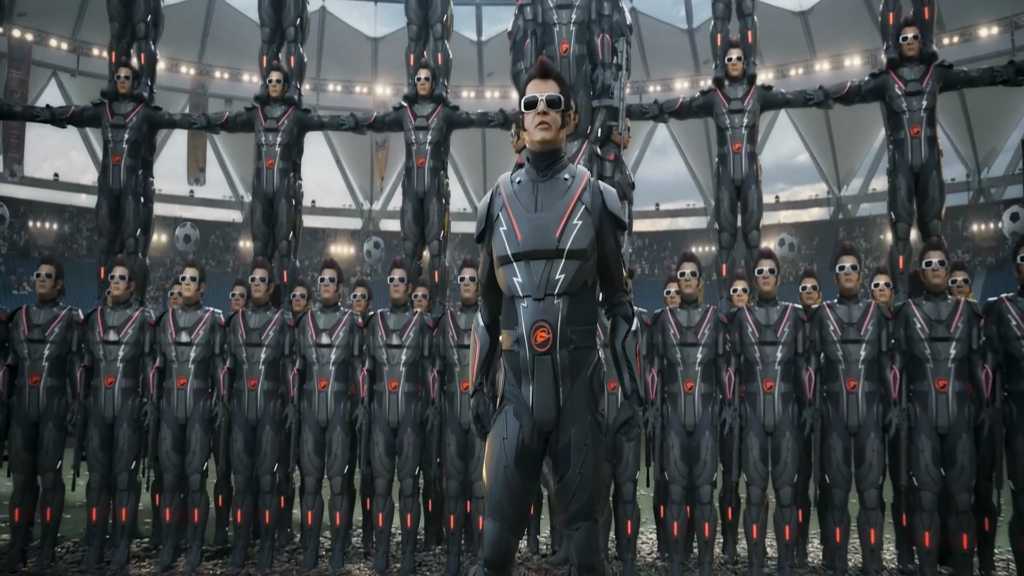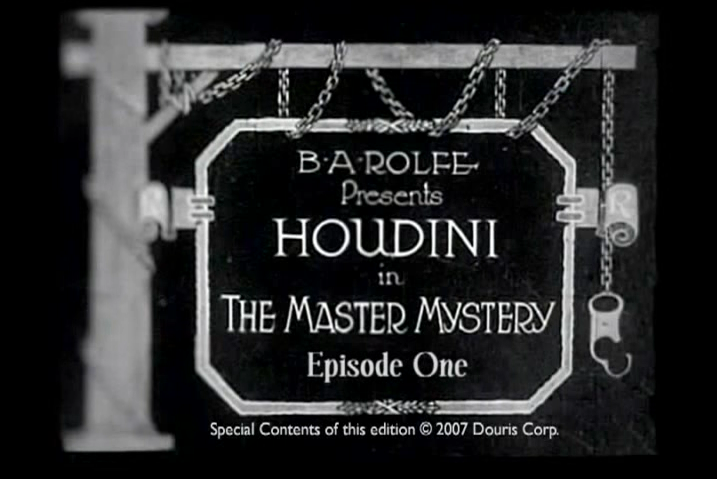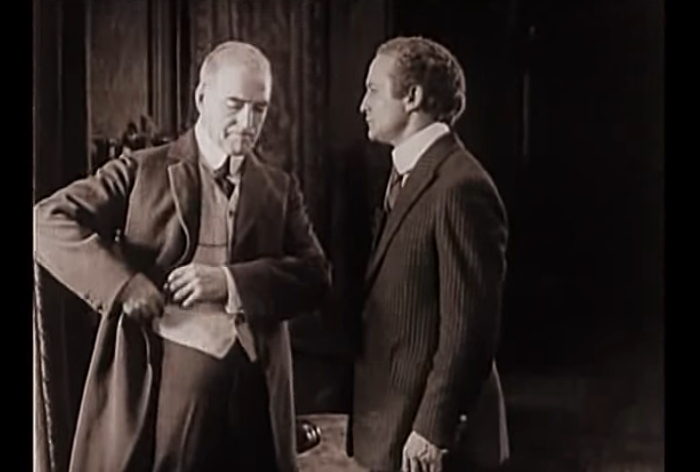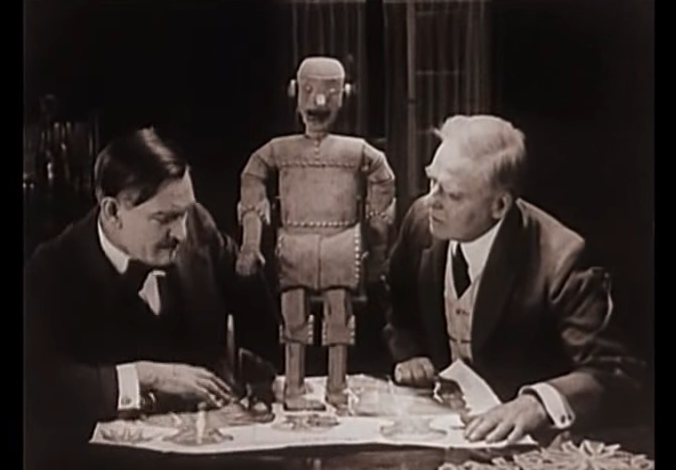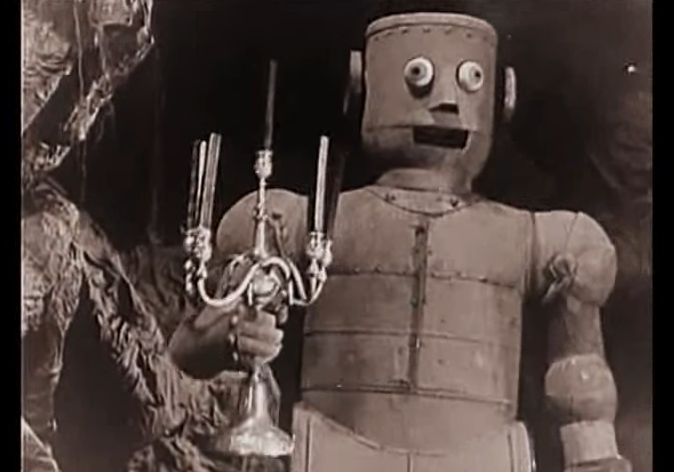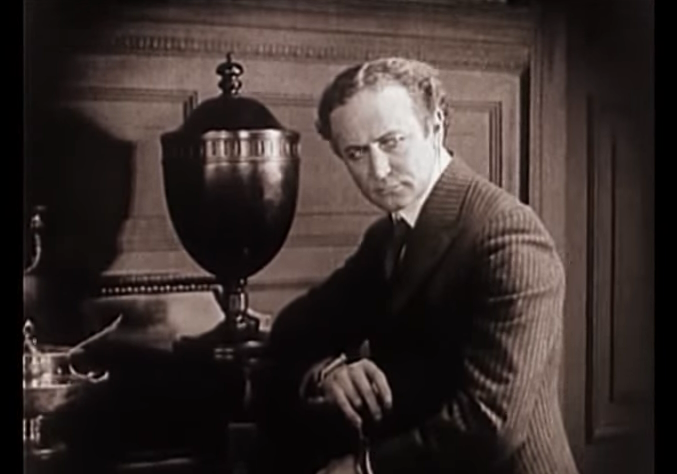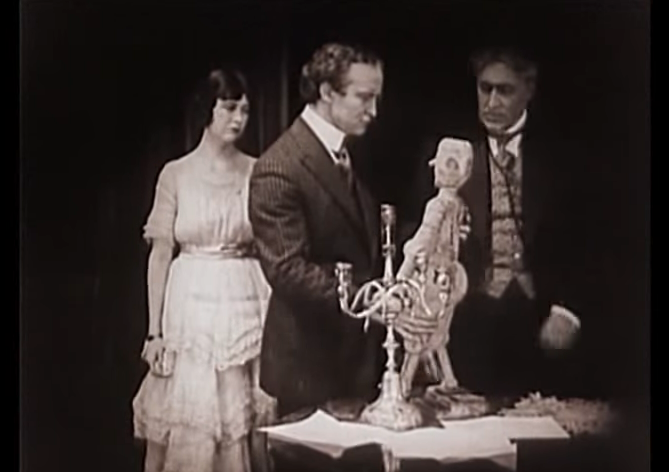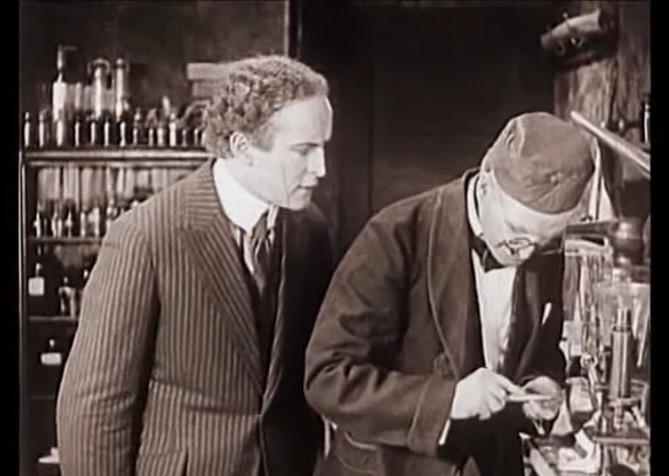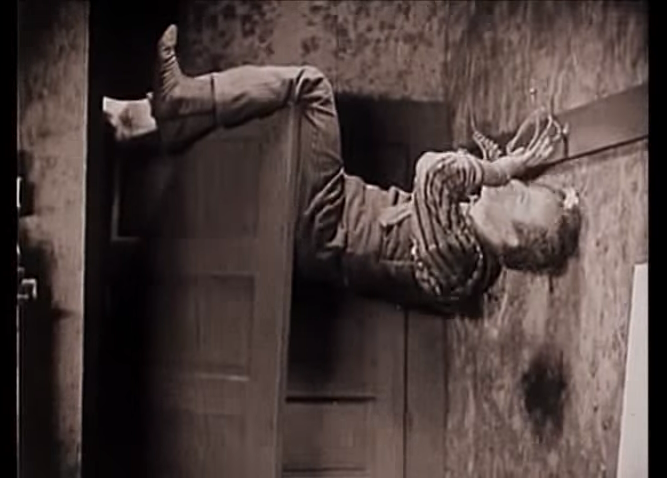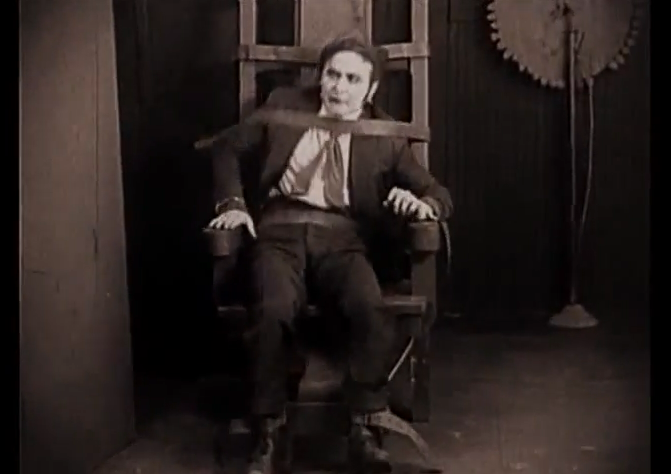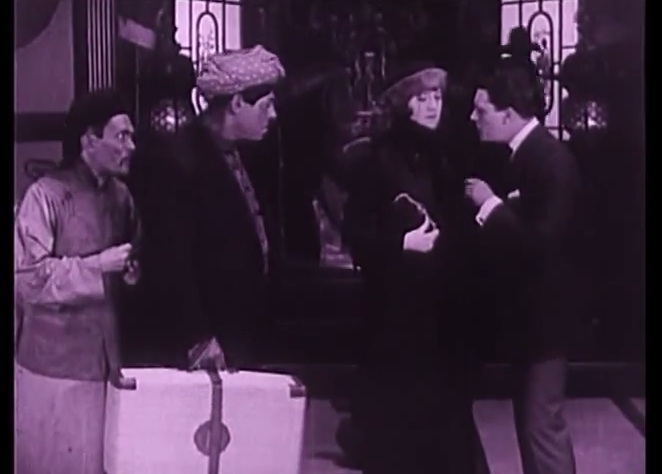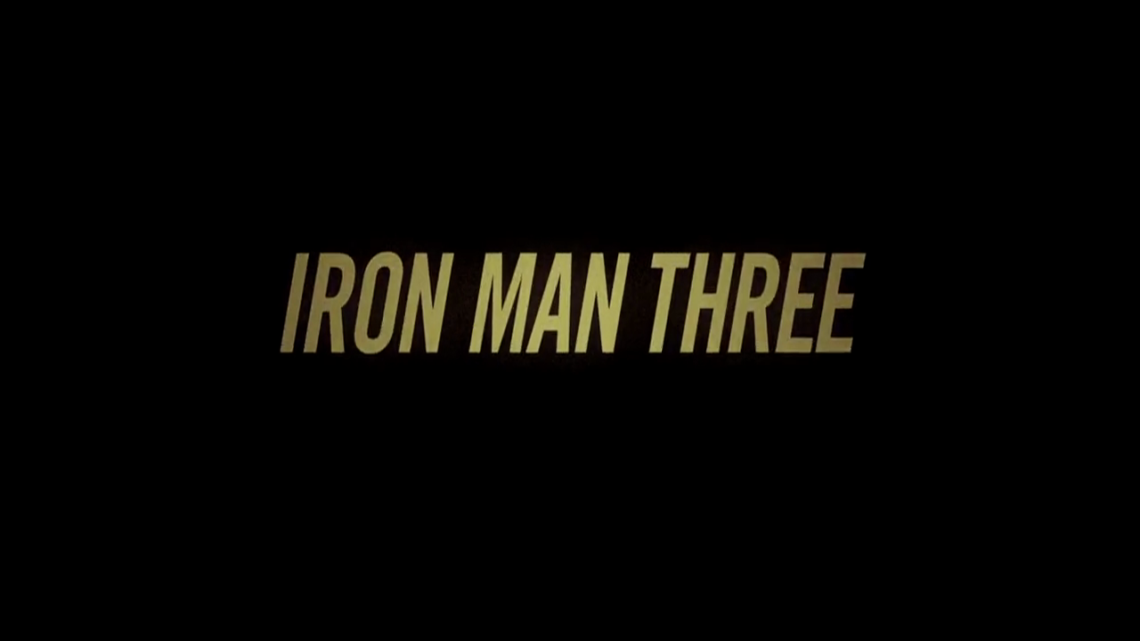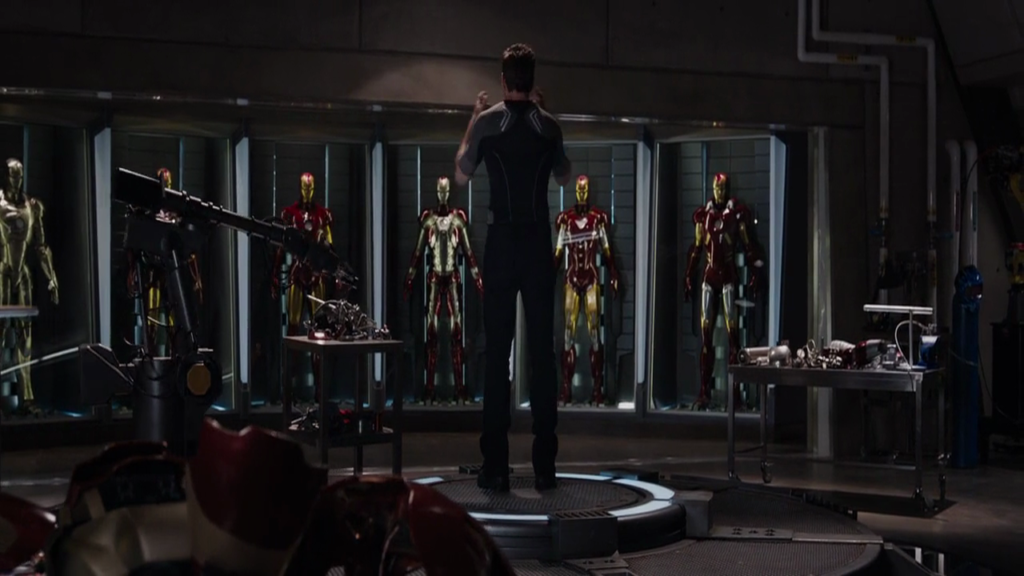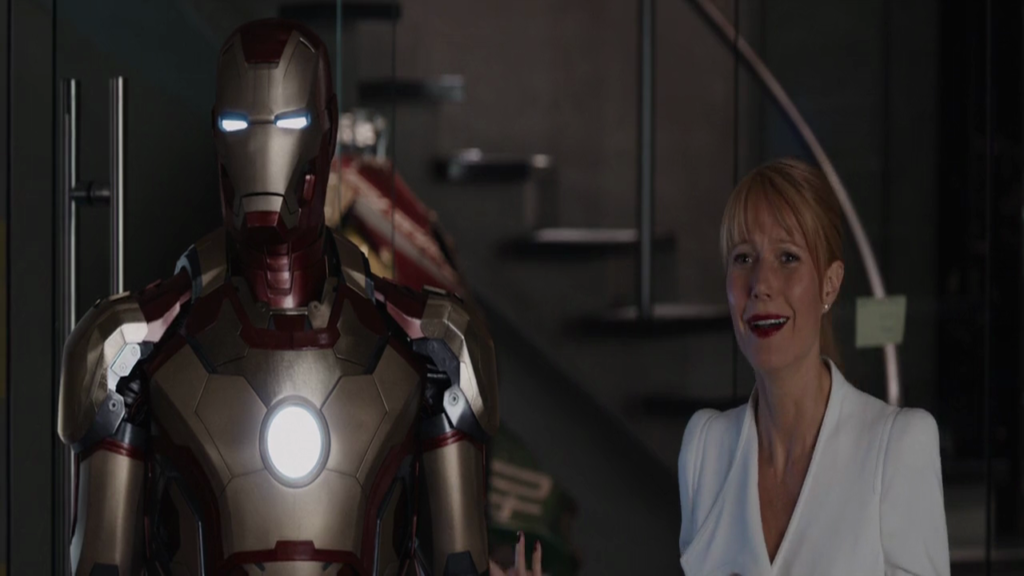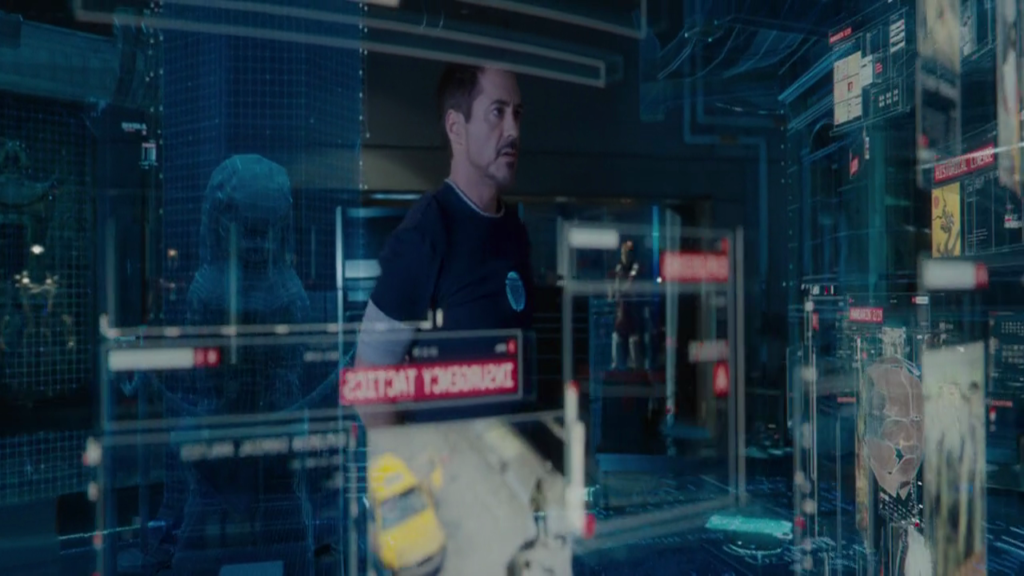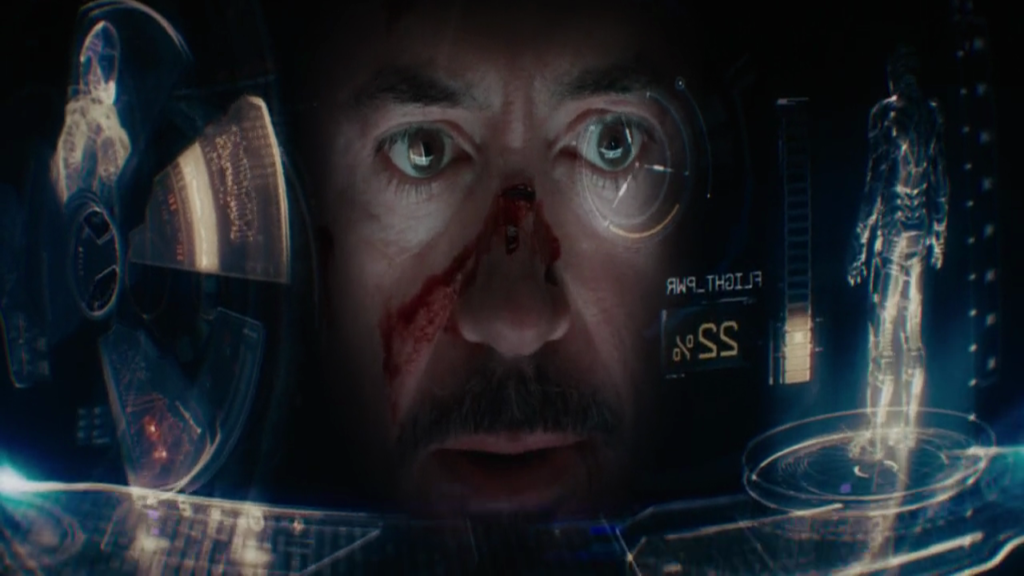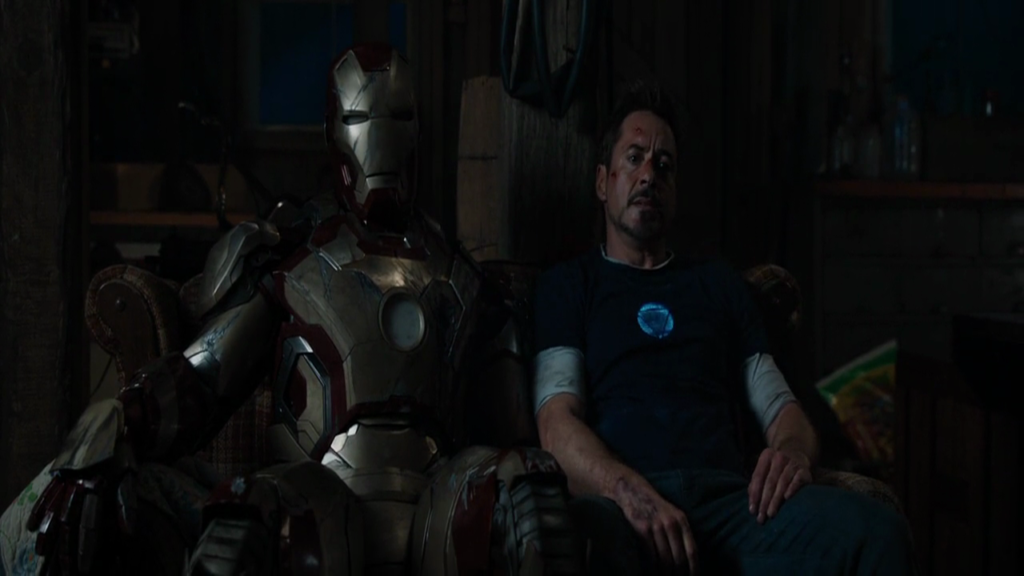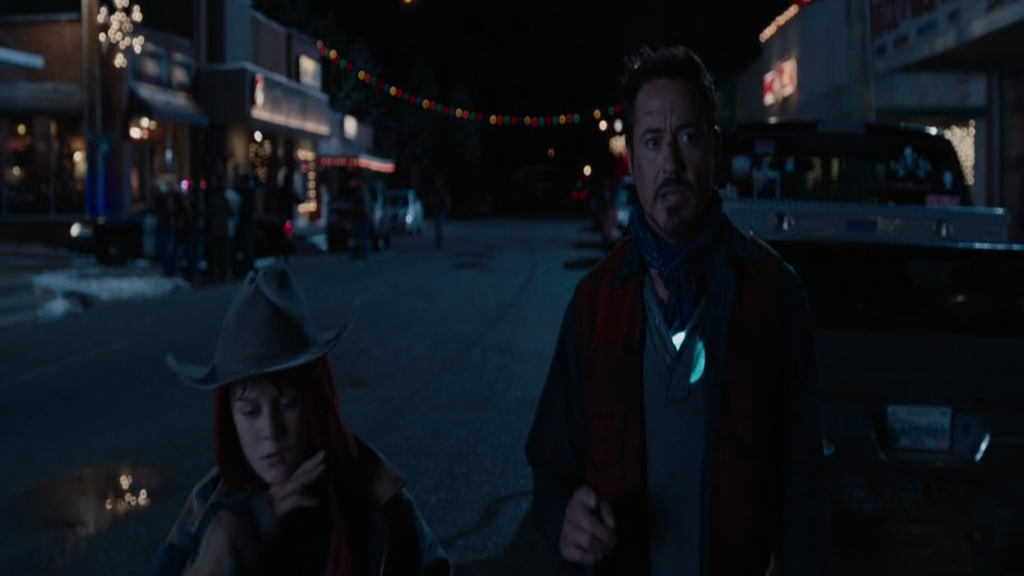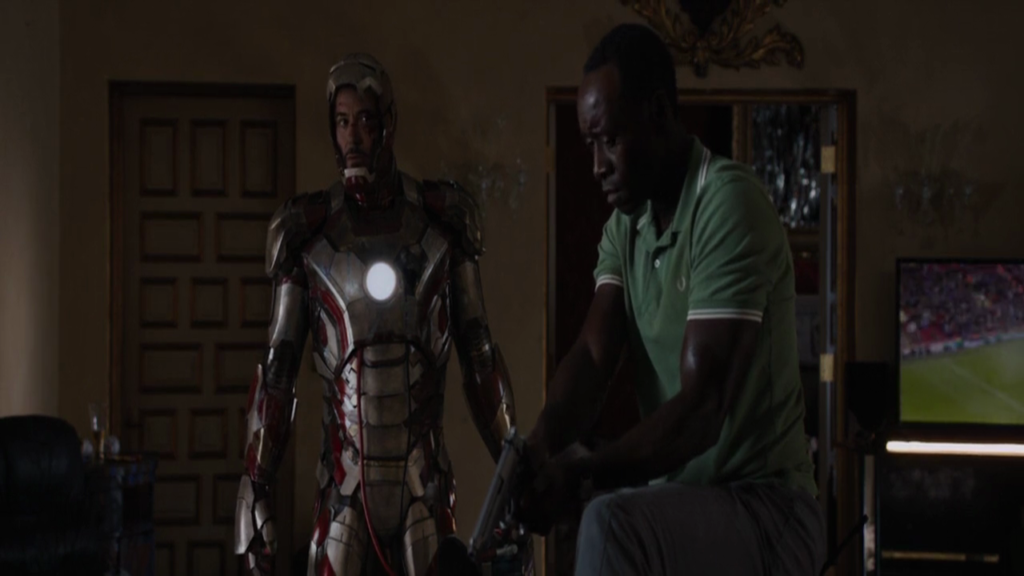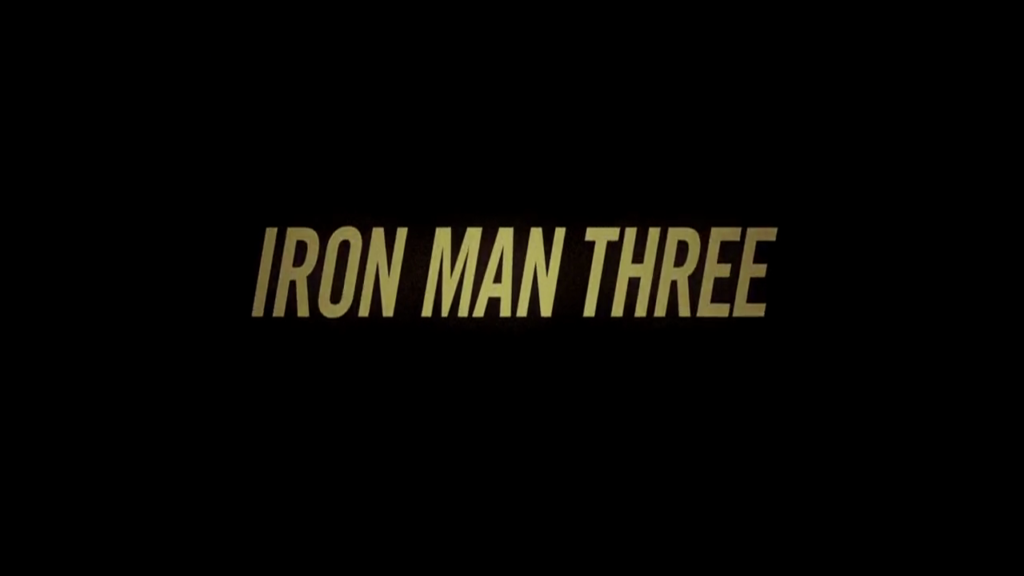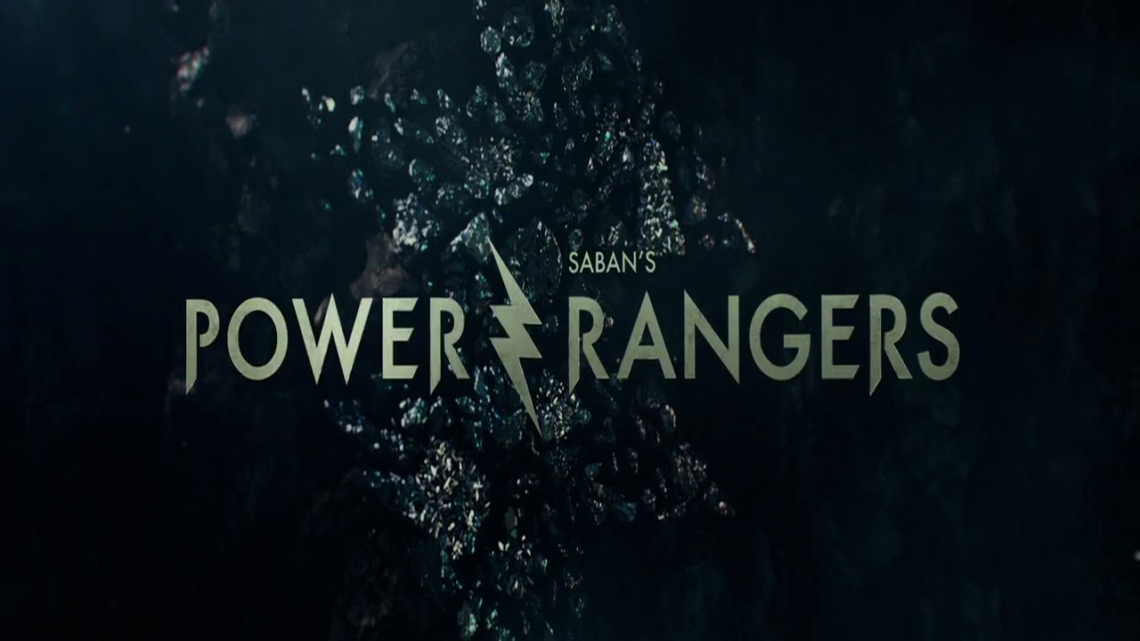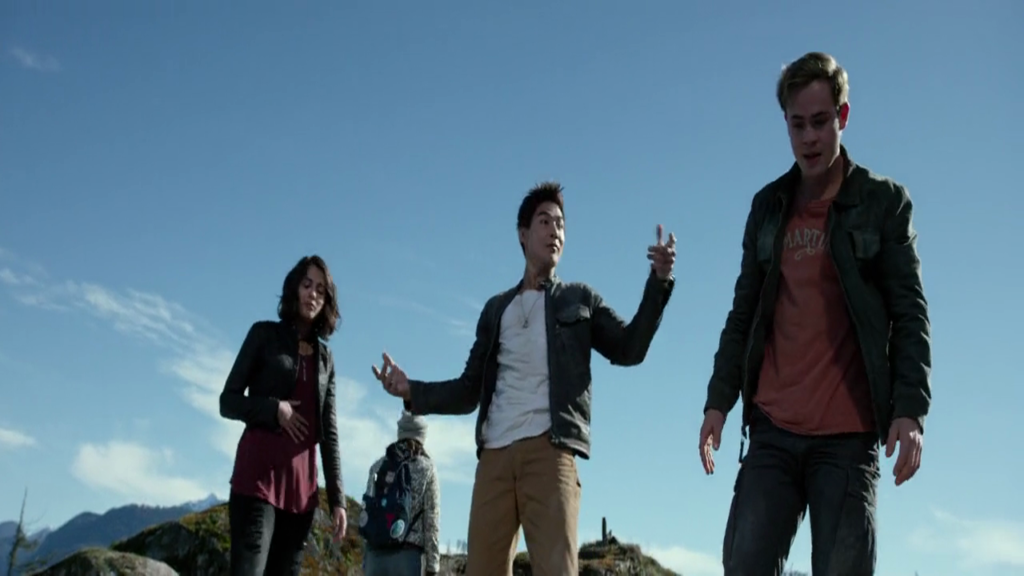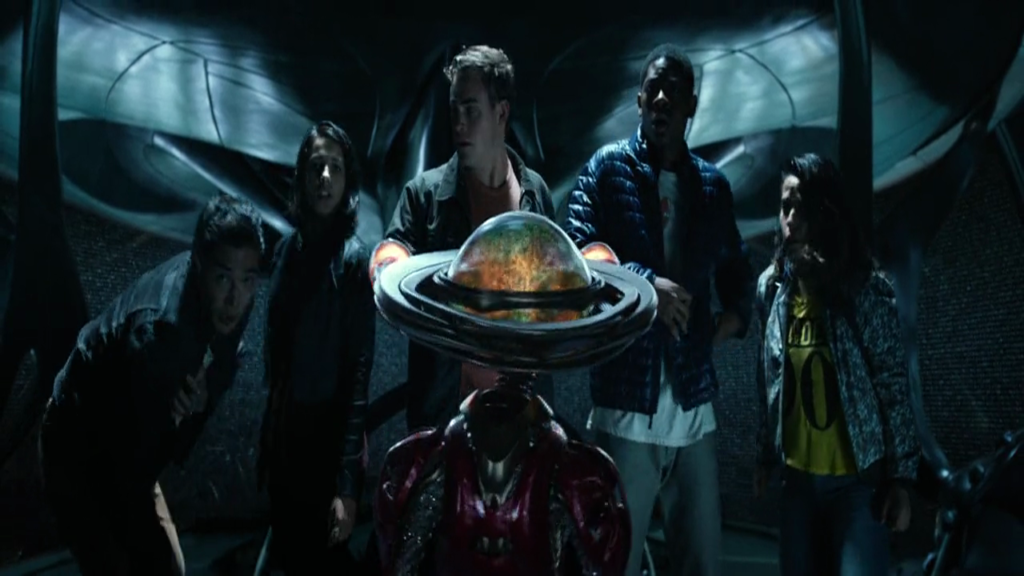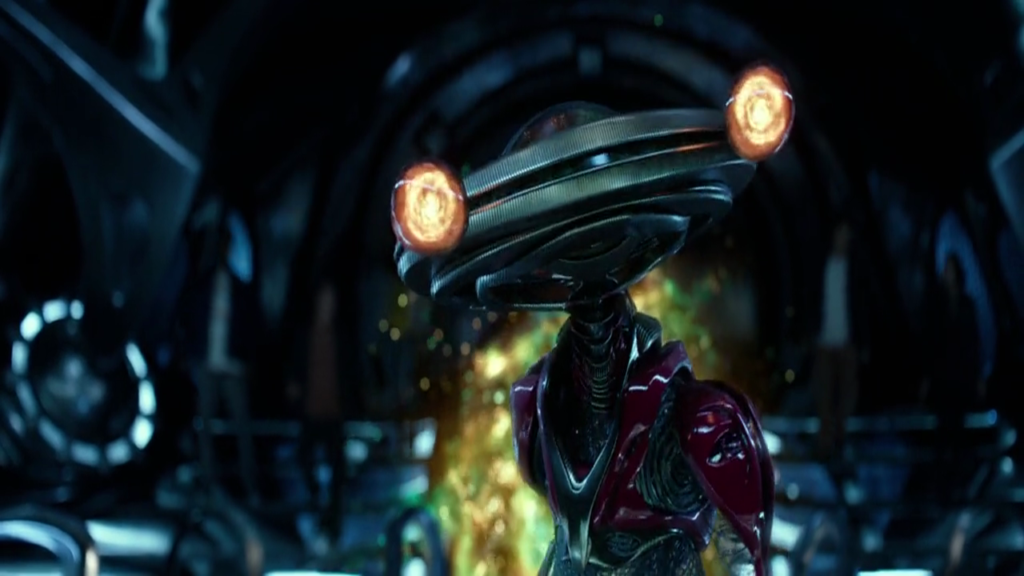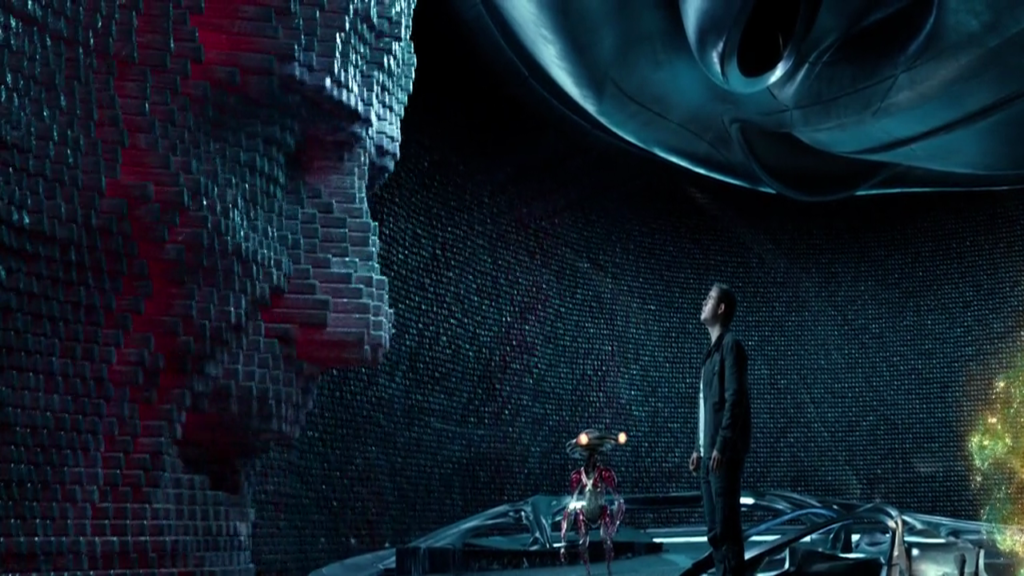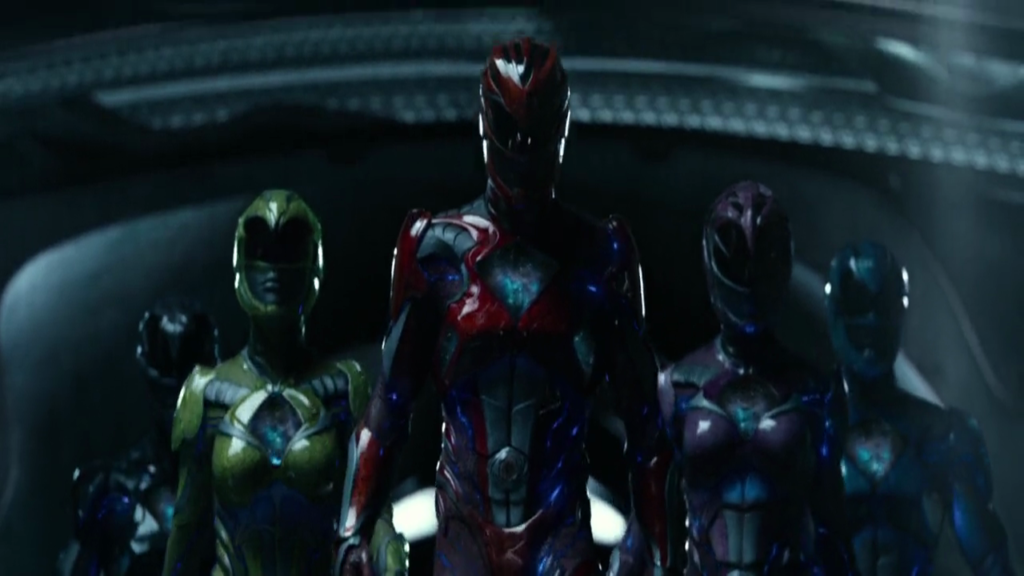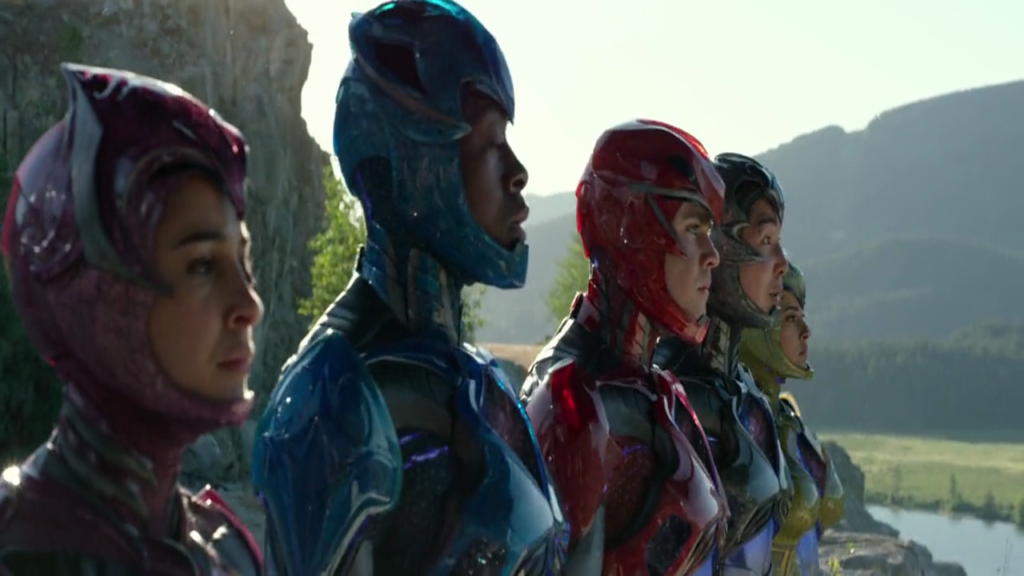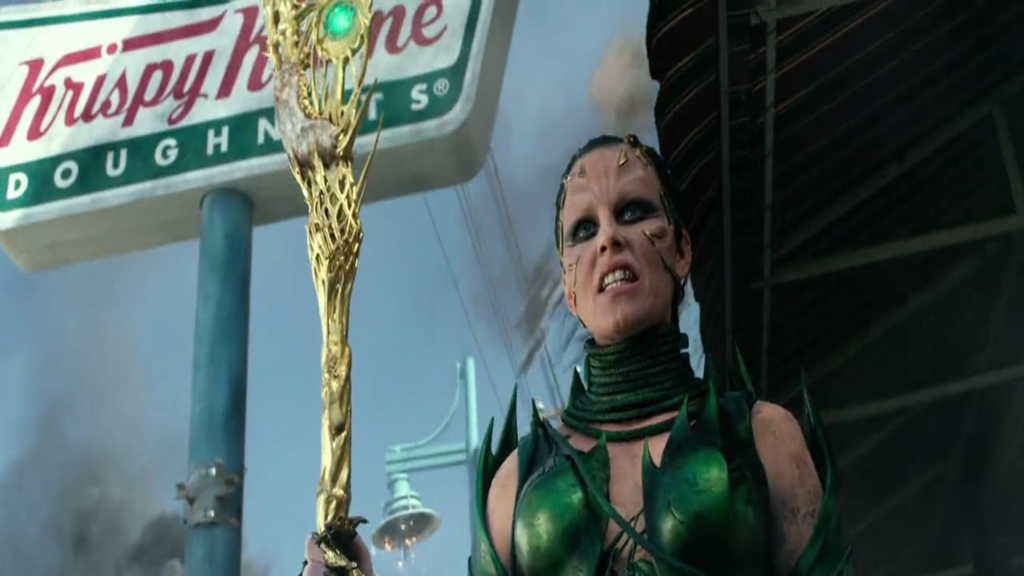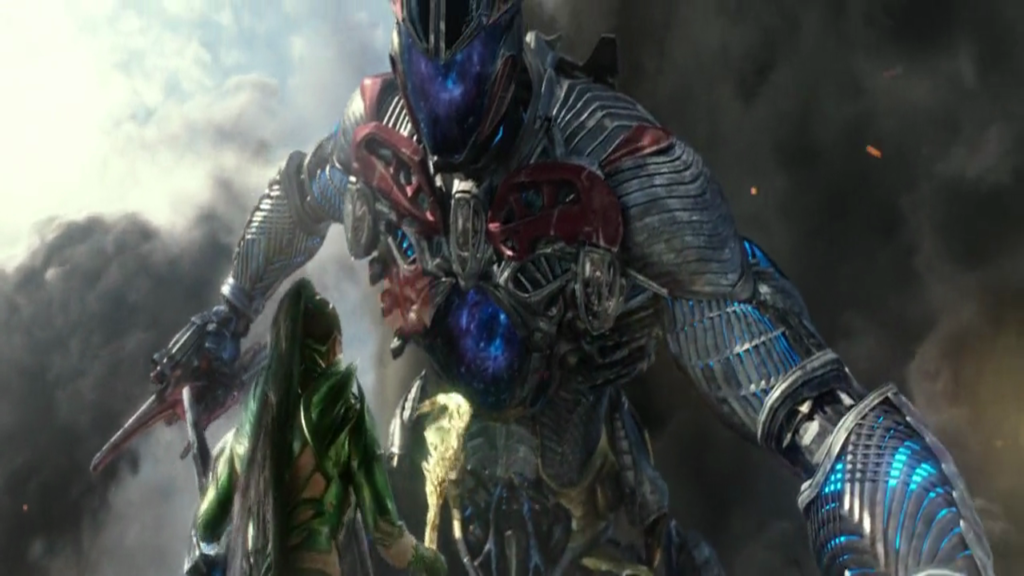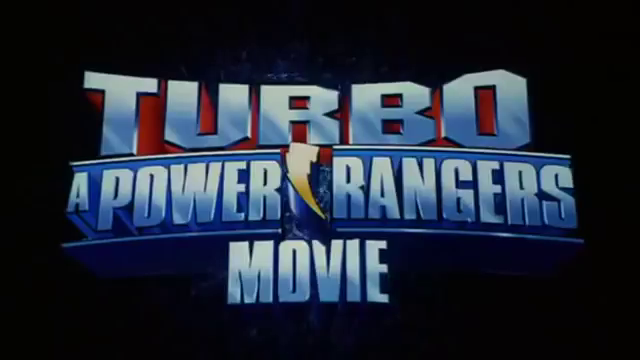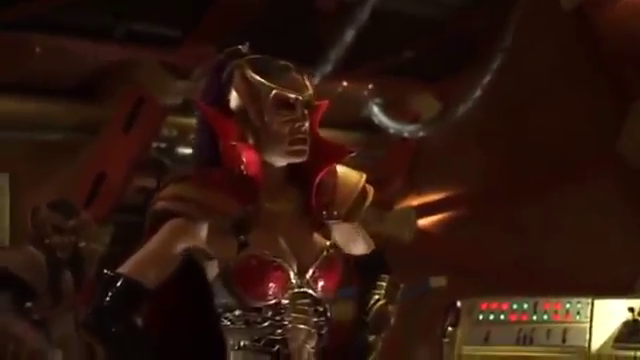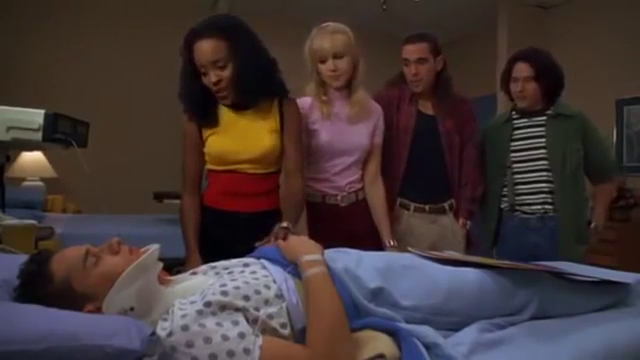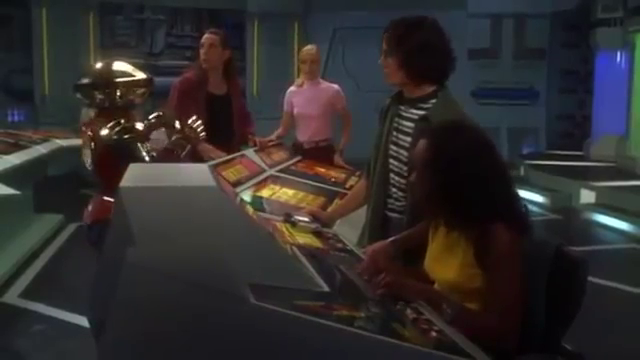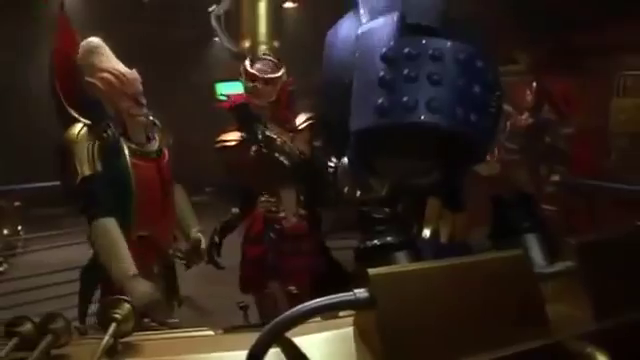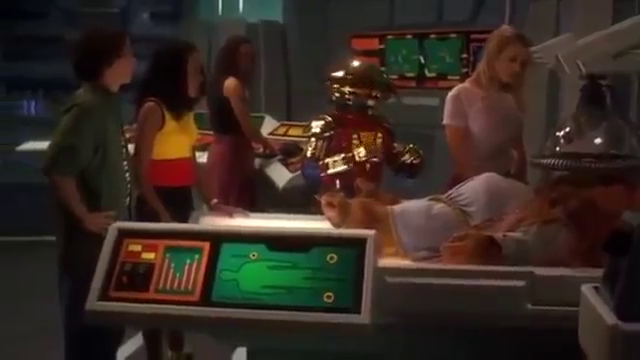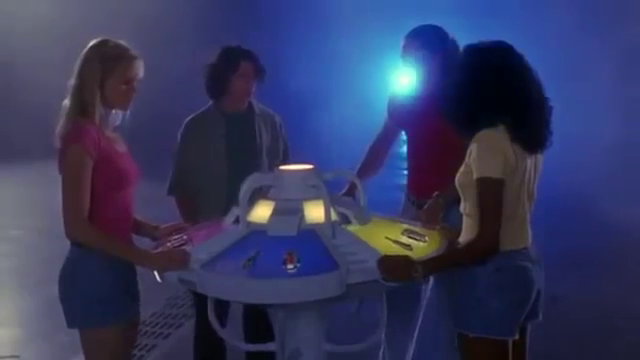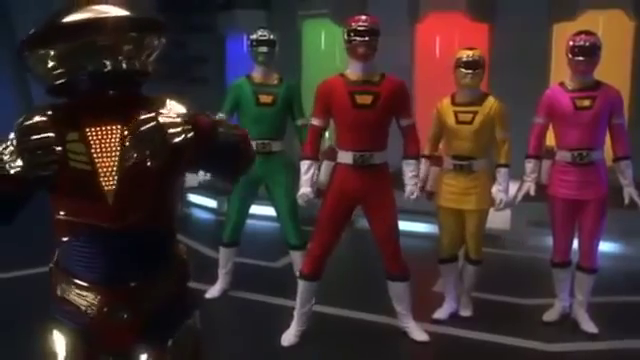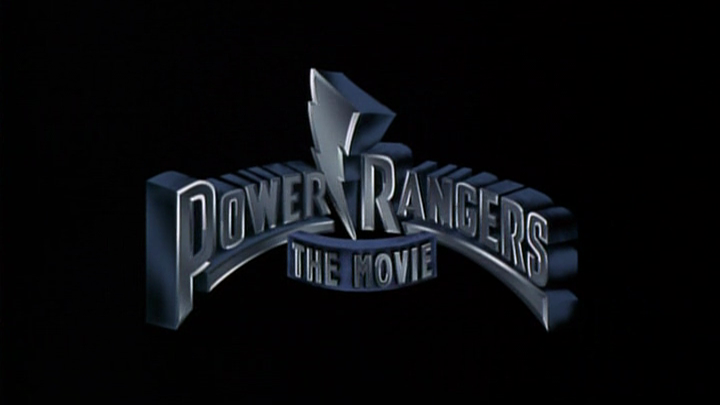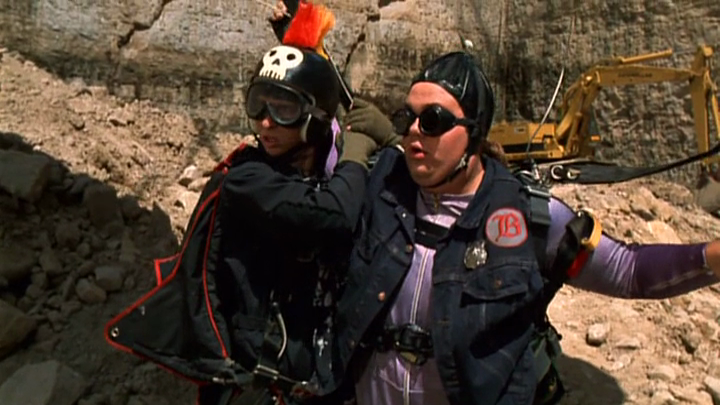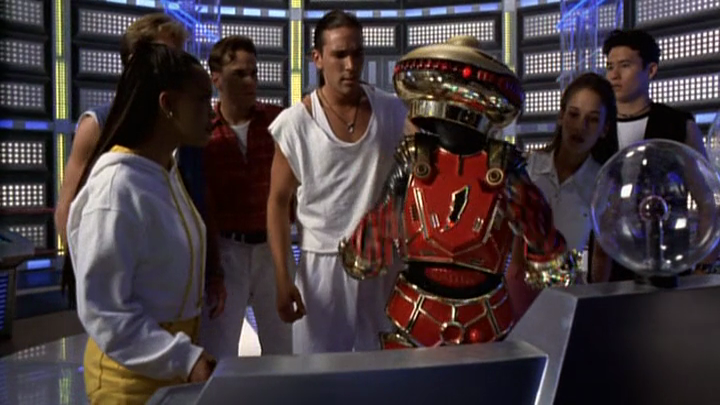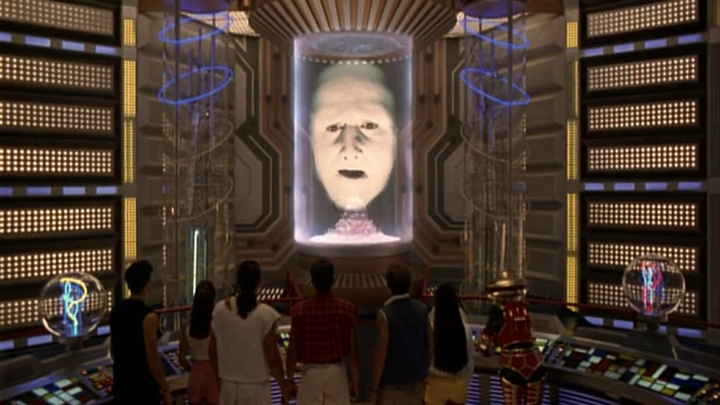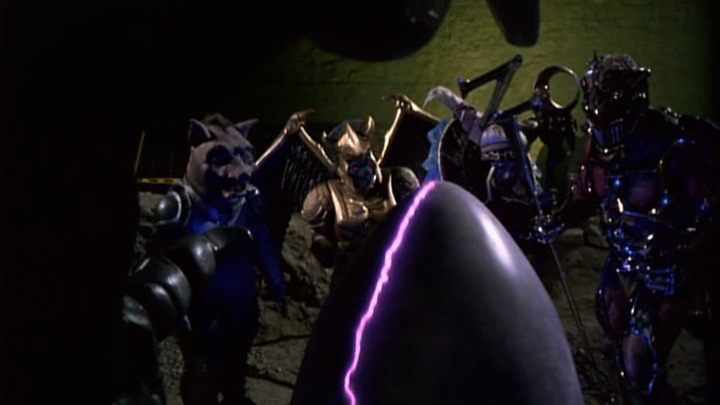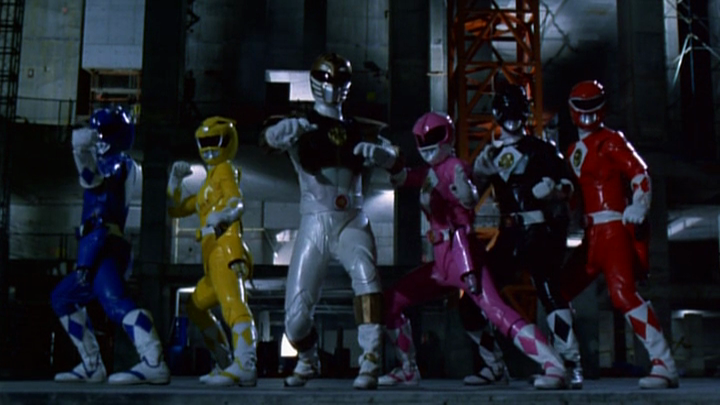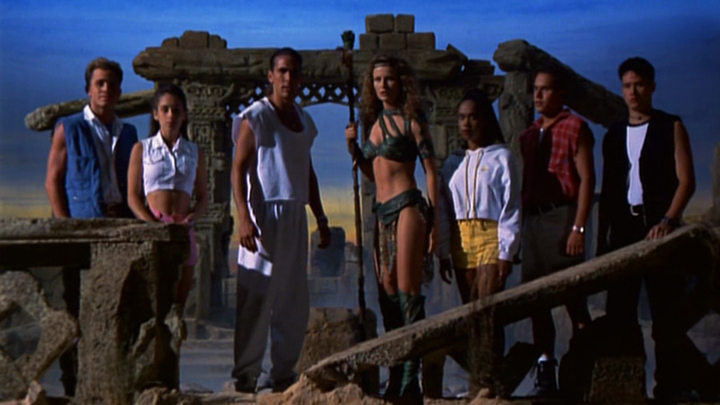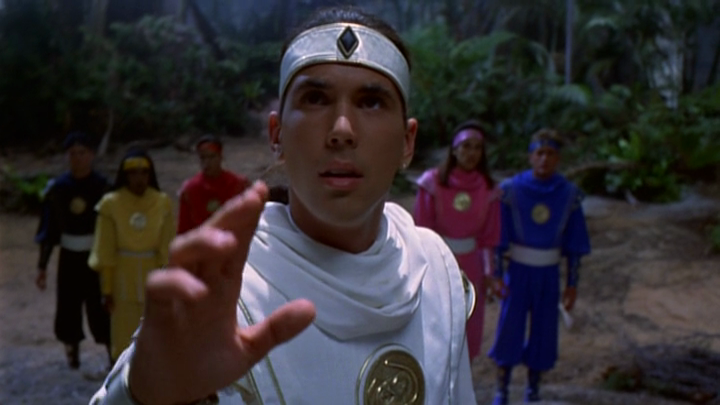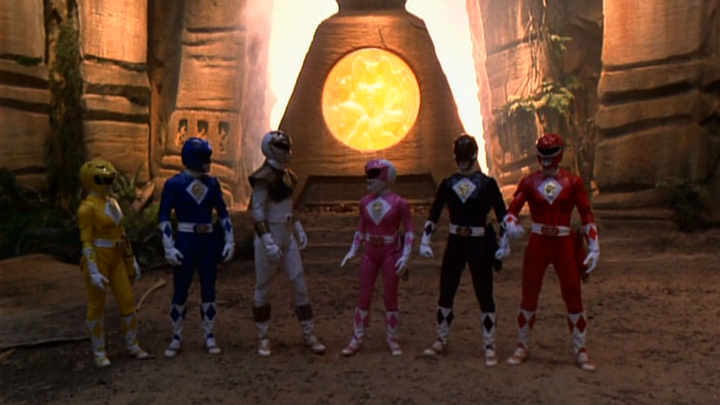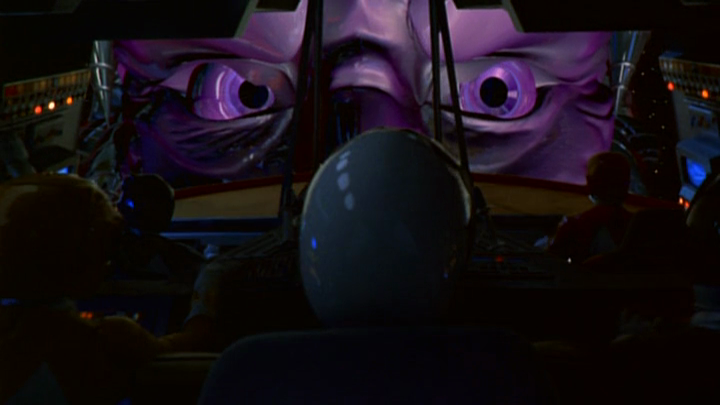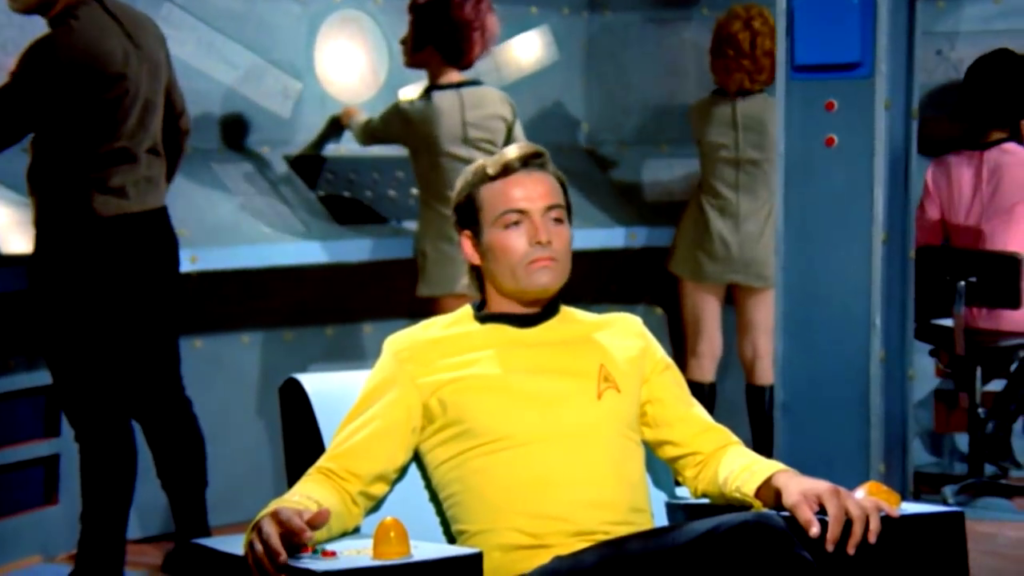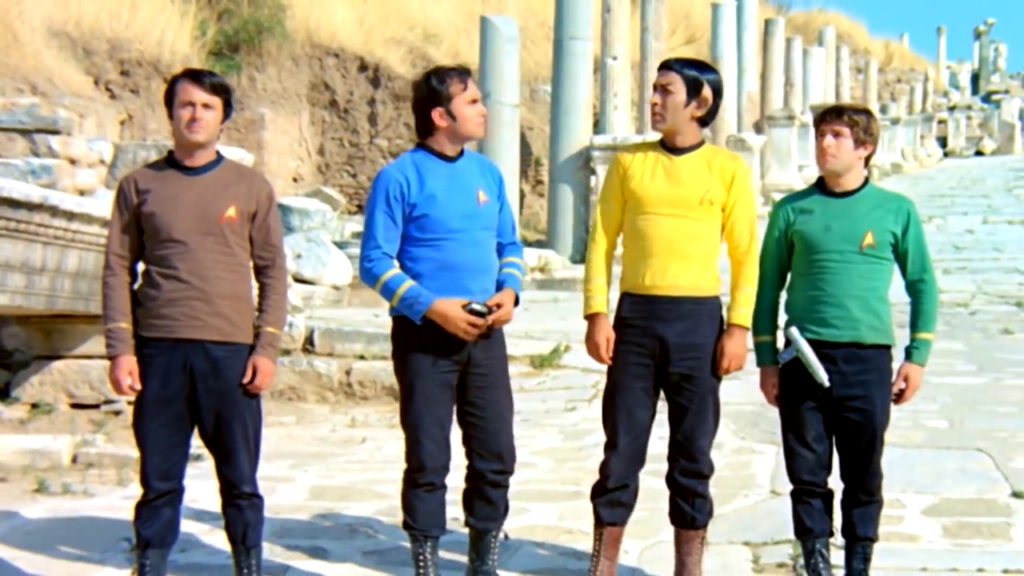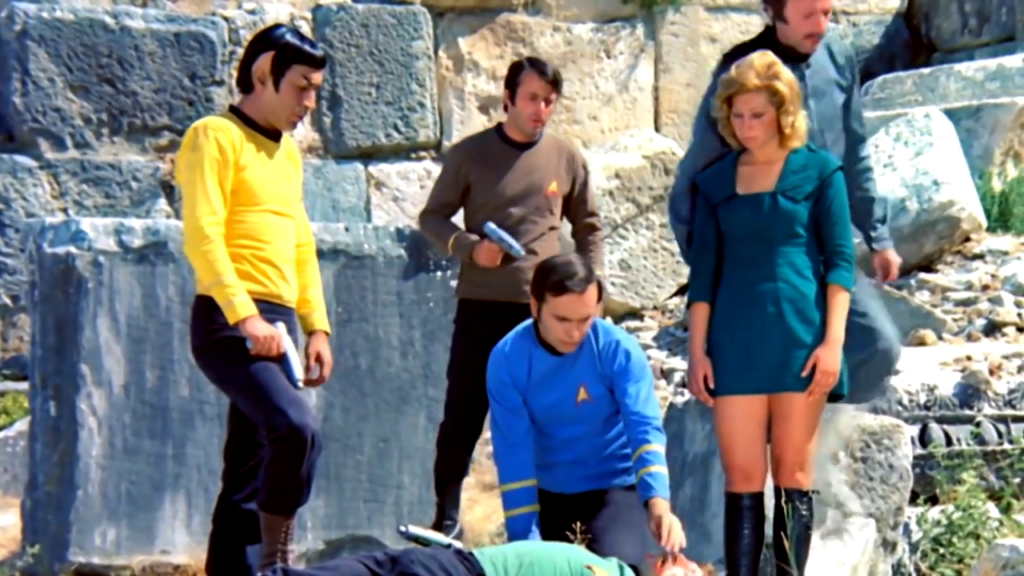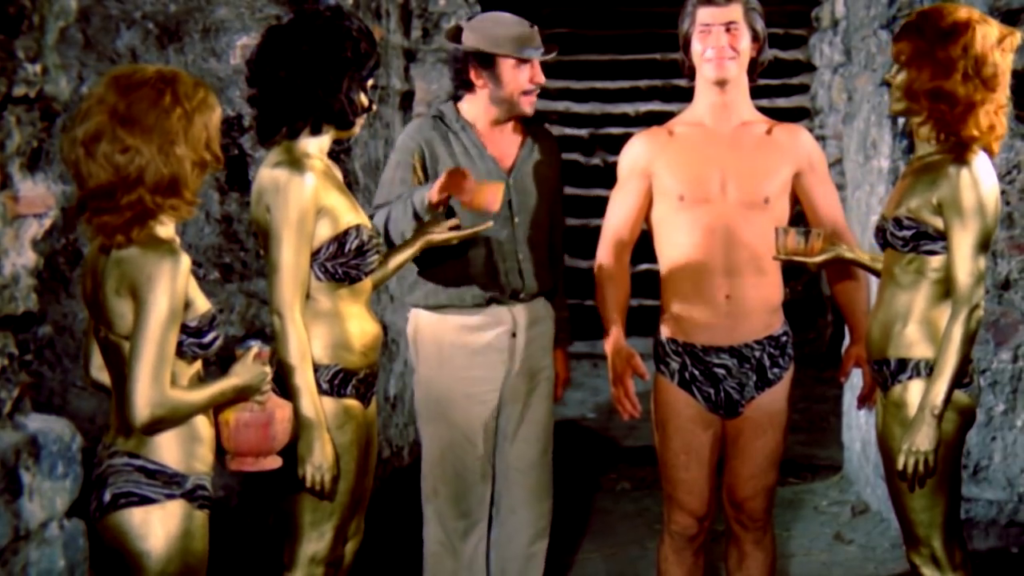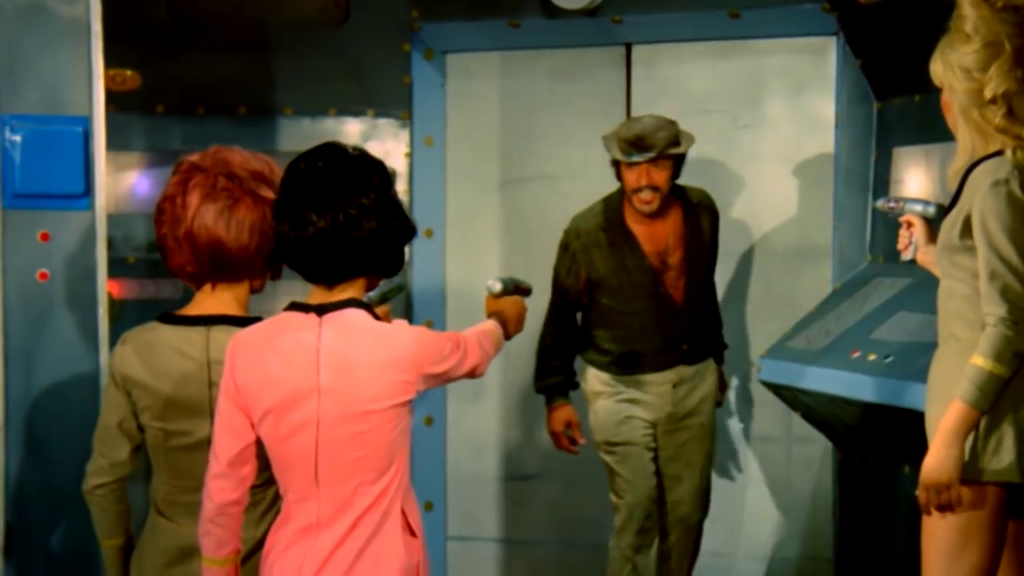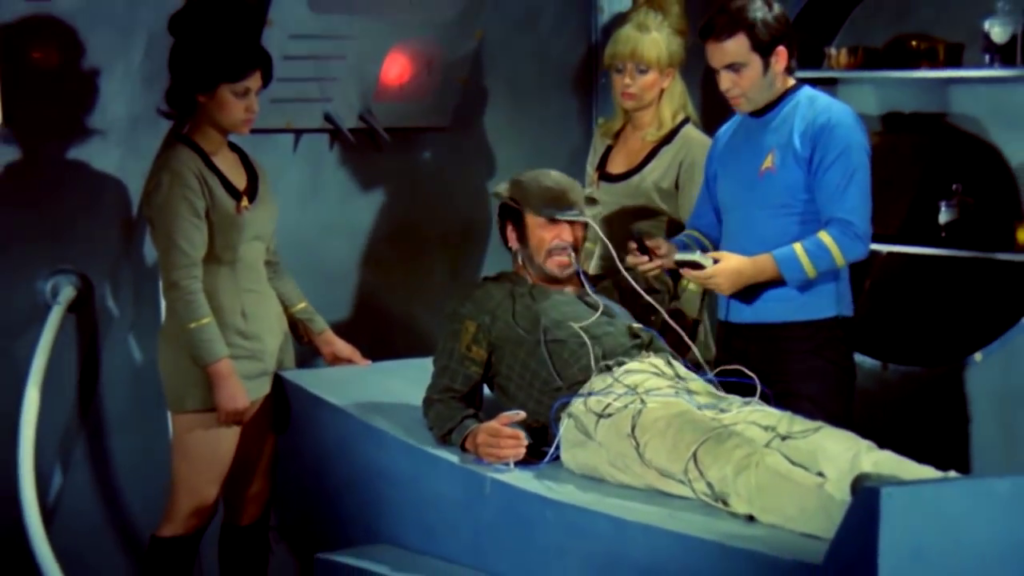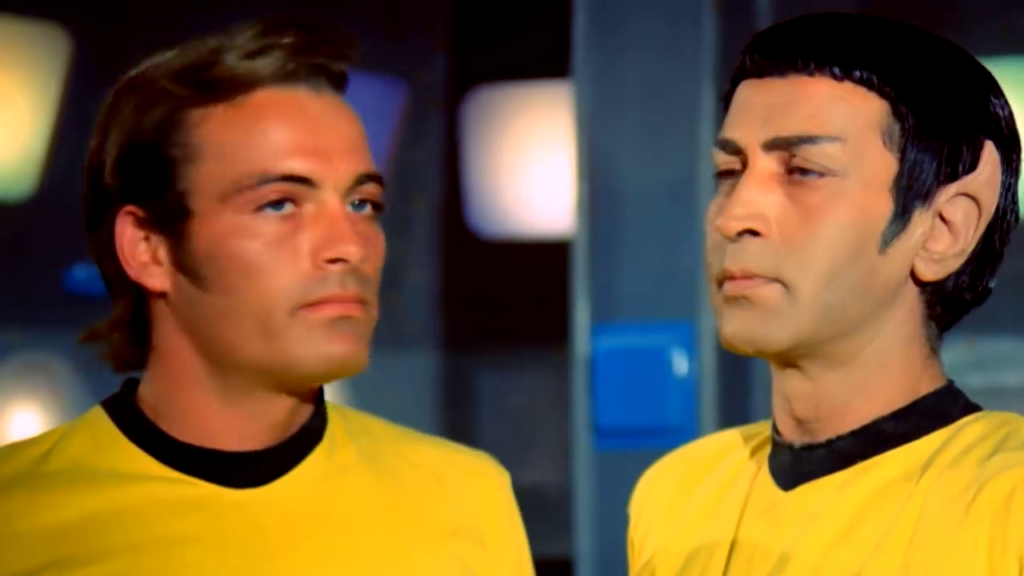-
#355 – Ku! Kin-dza-dza (2013)
Ku! Kin-dza-dza (2013)
Film review #355
Director: Georgy Danelia, Tatyana Ilyina
SYNOPSIS: A world-renowned cellist is on his way home when he is approached in the street by a young DJ claiming to be his nephew. The two see a strange looking fellow who wants to know “the number for their planet”, and when they press the button on the device in his hand, are instantly teleported to an alien world. The two of them must work together to find a way home, while also trying to navigate a dystopian society that very little sense to them…
THOUGHTS/ANALYSIS: Ku! Kin-dza-dza is a 2013 Georgian/Russian animated film, and a remake of the 1986 soviet film Kin-dza-dza. The original is a much loved film in it’s home countries, and is a very good dark comedy that also addresses issues of discrimination through its absurd setting. The story of the remake is very similar to the original: some of the scenes are practically identical, and for the most part, it captures the essence of the first film pretty well. Vladimir Chizhov and Tollik Tsarapkin are teleported to a distant alien planet after accidentally pressing the buttons on a device that a strange man was holding on the streets of Moscow. They find themselves on the planet Pluke, and encounter Bi and Wef, a pair of locals who try and swindle the two of them out of everything they have. The group forge an uneasy alliance as Uncle Vova (Vladimir) and Tollik try to find their way home, all the while trying to adapt and survive on this planet whose social structure is completely unlike anything they have ever encountered, such as social status being at least partially determined by the colour of one’s trousers. The film retains the story of the original, and so keeps most of the fun and satirical elements that made it so popular. In some parts the darker elements feel a bit lighter, as this remake is intended to be aimed at a more general audience.
One of the biggest changes is the names and occupations of the two main characters have been changed: Vladimir is now a world renowned cellist (in the original he could play the violin, but the instrument wasn’t his) instead of a foreman, and Tollik is a DJ. One of my main criticisms of this remake is that these small changes do end up ultimately harming the essence of what made the original successful. One of the key strengths of the original was the banality of the main characters and their mundane existence suddenly having to cope with the rules and social structure of an alien planet. In this version, having Vladimir be a famous violinist sets him up as having a backstory that disrupts this banality. There’s also a story about his ex-wife that is quietly built up in the background too, which again loads up the character with a bit too much baggage, rather than a blank slate that doesn’t bring as many complications into the story. Having Tollik be distantly related to Vladimir as well undoes the original’s premise of two men who just happen to be walking down the street at the same time and having never met each there before having to work together on an alien world is complicated through trying to develop these characters independently of the situation.
There are some changes, however, which add some good and interesting takes on the story. Being an animated film, there’s much more scope to be creative with the characters and design of the alien world. There is, of course, a risk of again disrupting the plainness of the original by being too over-the-top and fantastical, but to the film’s credit, in this respect it pulls it off quite well. Being set on an alien world, the characters are drawn with a more alien appearance, but they’re just alien enough without it being distracting. Other minor characters are more odd in appearance, but since they’re only on screen for a short time they don’t disrupt the tone of the film. Credit should be given to the film for achieving this balance. The animation in this film should also be commended: it is fluid and full of expression, and offers some detail and scenery that the original could not provide.
Overall, Ku! Kin-dza-dza is a faithful remake of the original, but ultimately doesn’t offer anything new or improve on what has gone before. The original was a sparse, small production, whereas this remake has a big budget and funding to appeal to a larger audience, and the changes that are made to accommodate this mostly end up affecting it a negative way. It’s not a bad film, because it sticks close to the original, and the original is very good: but when you’re remaking a film that was more or less perfect, you need to have a damn good reason to do so. Changing it to an animated film brings with it some benefits, but on the whole there just doesn’t feel like there’s enough substantial difference to justify the remake, and there’s no real reason to recommend it over the original.
-
#352 – 1. April 2000
1. April 2000 (1952)
Film review #352
Director: Wolfgang Liebeneiner
SYNOPSIS: In the year 2000, the newly elected Austrian Prime Minister declares that the country will no longer be making payments to the World Union and declares its independence of the Allied forces that have overseen it after the end of the second world war. This brings down the wrath of the World Union, whose president sees them as a threat to world peace and arrives in Austria in order to put the Austrian Prime Minister on trial that very crime. He defends himself by showing the World Union that he is no threat, and that the rich cultural history of Austria is a legacy of peace and unity.
THOUGHTS/ANALYSIS: 1. April 2000 is a 1952 Austrian sci-fi political satire film.The film takes place – as the title suggests – in the year 2000, some forty eight years after the film was released, and sets the scene as a possible future based on the (then) current situation in the world following the second world war. The backstory being that Austria, having been a part of the alliance that lost the war, were subject to oversight from the winning alliance and had to make reparations to them. The film opens up with a newly elected Austrian prime minister announcing that he is refusing to pay anymore reparations to the World Union (a not-so-subtle parody of the United Nations), and is declaring Austria independent of the allied powers of the U.S., U.K., Germany and the USSR and their oversight. The citizens are overjoyed at this, but this act of rebellion does not go unnoticed at the World Union, and they have sent their troops and president to “maintain peace.” They put the prime minister on trial, accused of disrupting world peace, and he must defend himself and his country by showing the World Union that they simply wish to be free, and present no threat. This is done through showing the various achievements in Austria throughout history, and its value in the larger world. The film goes through the various stages of this trial, with the prime minister showing evidence that acts as a historical lesson for the World Union and the viewer. The message of the film is rather plain to see, even if it is set in the future: that there is no need for the allied powers to occupy and oversee Austria to prevent another world war, and it is a country that simply needs to be free…and this is as true in 1952 as it is in the speculative year 2000. All the arguments made in the film could be made for the time that the film was made, but the setting of the future shows that there could really be no end to the reparations and oversight, and there is no ideal time at which it should be stopped, so it should be ceased immediately. The film’s strength lies in its informative message, while still managing to be entertaining, with an interesting cast of characters, and the almost haphazard approach of the prime minister creating his defence with no time to plan further shows that their is no grand scheme or plan in his head, just the simple idea of freedom for his country.
The setting of the year 2000 is a future filled with super fast rockets for travel, laser guns and ridiculous headgear for TV camera crews…but apart from that nothing seems vastly different in this future. This may be because Austria cannot afford any new technological advances under its oversight, or simply that the film is focused more on showing Austria’s past, and so it being too futuristic would distract from that. Either way, these futuristic elements are shown to do nothing to fix the basic problems that the film is trying to address. For example, when the World Union’s rocket is heading for Austria with its troops, they accidentally go to Australia instead, which shows their lack of consideration or interest in those countries it is leaving behind technologically, as well as a typical bureaucratic blunder people can make. The effects for the spaceships are quite well done, as they land around Austria’s cultural landmarks it gives it a real sense of authenticity. On the other hand, an element that hasn’t aged well at all is having all the different representatives of the countries of the world (black, Arab, Chinese) all being portrayed by white actors, which doesn’t really look good.
The satirical nature of the film means that a lot of the content is not too be taken too seriously, nevertheless there is a serious message that the Austrian government (who funded the film) wanted to project: that they were a legitimate country with a rich history, and should be taken seriously. Some of the plans of the prime minister include putting on plays and composing songs to persuade the World Union members to give Austria its independence, all of which are executed in a comedic manner that you can’t really take too seriously. The plot does go all over the place, and the ending makes the whole trial redundant anyway, which further emphasises the satirical, comedic aspect. Overall, 1. April 2000 is an interesting film that is informative, satirical and is a protest at the then current state of affairs through a science-fiction lens. While there is a serious message, it is wrapped up in theatrics, silly looking futuristic technology and ad-hoc schemes that are entertaining to watch while also not diluting the historical figures and events that it shows. Some of the dialogue and characters are outdated, and the story feels very loose in places, but again, overall it is an interesting look at a time where the world was rebuilding, and how the future might unfold without anything really changing.
-
#351 – 10000 Years Later (2015)
10000 Years Later (2015)
Film review #351
Director: Li Yi
SYNOPSIS: Ten thousand years after advanced civilisation was wiped out and the world reverted to a pre-technological state, Joma and Yalayam of the Ballad tribe are travelling the western region to tell the tale of the fall of civilisation. Unfortunately, Wugreb, who once tried to steal the ancient powers to rule the world, has returned, and Joma alongside her new friends must find a way to stop Wu before he releases the ancient civilisation’s power back onto the world, all controlled by him…
THOUGHTS/ANALYSIS: 10000 Years Later is a 2015 Chinese animated film. It is a mix of post-apocalypse, science-fiction and fantasy elements, as it is set (as the title suggests) 10000 years after civilisation suffered a catastrophe that sealed away all of its advanced technology and left the world in a pre-technological state. The world is now separated into various tribes, which include anthropomorphic animals and various mutations brought about by the catastrophe. Joma and Yalayam are from the Ballad tribe, who wander through the western region telling the story of the fall of the ancient civilisation to the other tribes. They also tell the story of Wugreb, who once tried to steal the ancient technology that is sealed away and rule the world with it, warning that anyone who tries to do the same will be met with the same fate. However, Wugreb (or Devil Wu, as he is also known) has returned, and is attempting to once again take the technology of the ancient civilisation for his own. The story relies a lot on this extensive world-building, and how the world has changed since the fall of civilisation as we know it. Sometimes it is easy to follow, but at some points it gets overly complicated, and for a film that is just over ninety minutes long, the explanations and exposition it gives do seem a little excessive. Nevertheless, it is an interesting world that is built, and the variety of locations and characters give it a unique sense of life and vibrancy. The people refer to famous people throughout history (Einstein, Beethoven etc.) as the “Gods” of the old world, and it is an interesting way to interpret history’s most pivotal figures. There are these odd scenes which play out quite nicely, but they are mostly used to explain the state of the world, and when the film returns to the main characters, they seem much less interesting.
Joma goes to see an oracle, who tells her that she is the only one who can stop Wu, and she must go to Kuger, the tomb where Wu was imprisoned, to stop him. Along the way Joma is joined by a cast of characters from different tribes who all inject their own personalities into the film. The film very much has a Lord of the Rings feel to it, with the group travelling to their destination to stop the oncoming evil, and all the perils that they encounter. But again, there’s a lot of backstory and exposition that disrupts the flow of the film, and you really have to focus and pay attention to follow what is going on. The characters on the whole, though, are distinct enough to be able to follow, but for all the explaining and exposition, don’t really do much, so it’s hard to get to know them as characters. At once point the film deals with the meeting of the Gods which I can’t really make sense of; and whether they are actual Gods or not is anyone’s guess. Joma as the main character is also a bit bland and uninteresting: even though she is marked as the chosen one, she doesn’t really have any defining traits or character defining moments that make her stand out, and she is often very passive to the events of the film. The ending of the film also does little to elucidate the significance of Joma’s role, and makes little sense. The designs of some of the villains, with their multiple faces or limbs and other bizarre features are both scary and creative, and the somewhat imperfect animation actually helps exemplify their grotesqueness.
This film is entirely CG animated, and for the most part it creates a world that has immense scale, colourful diversity and interesting locales. We see ruined versions of recognisable cities such as New York and Sydney, which add some interesting shots and perspective on the story. There are some moments when the animation gets a bit clunky, and facial expressions and movements sometimes look a little stifled or flat, but otherwise it doesn’t distract too much from the film. It’s not cutting edge in terms of its graphics, but it is passable for a kids film. Apart from the Lord of the Rings influence mentioned above, there is also a certain amount of ‘inspiration’ taken from the Marvel Avengers films. When I say inspiration, that often becomes blatant copying, such as the five stones that Joma carries containing seeds from across the western region clearly being based on the “infinity stones” in the Marvel universe, and there is a shot which copies exactly the iconic shot from the 2012 Avengers film of all the superheroes together for the first time on the streets of New York City. All this copying does cheapen the film’s overall image, but being a Chinese film, where these films would not have seen much of a release, the audience probably won’t even know they are being copied. The editing of the film also feels quite choppy in parts, such as when the big final battle begins, the enemy soldiers slowly emerge, and it instantly cuts to the whole army appearing, which really interrupts the flow of the film (though it probably saves on the animation costs).
One more significant aspect of the film is the amount of gore and violence throughout. I can’t really tell what the ideal age range is for this film: it seems mostly kid-oriented, but even from the opening, there are people being sliced up, bloody battles with people being cut in half and stabbed, and so on. I’m not sure what the standards are for Chinese cinema in terms of violence in children’s films, but it definitely wouldn’t be a child-friendly film in the west. Overall, 10000 Years Later creates an interesting and colourful world with a rich back-story, but the focus of the story and its main characters are often lost in the overly complex world and narrative that can be difficult to follow. The character designs are creative and unique, but again the personalities of the main characters are dull by comparison, and often get lost in the grand scale of the world. The large-scale battles are impressive and entertaining, but it is obvious that they are copying from the Marvel films and Lord of the Rings, which obviously do them much better, and make the film feel like a cheap imitation…which, let’s be honest, is exactly what it is. There are some emotional moments (there’s a scene right at the start which pulls you in instantly…you’ll know it if you see it), and the gratuitous use of gore and violence really gives weight to the fighting scenes, but ultimately there is no real pay-off to investing in this world, and it offers very little that is unique.
-
#350 – 2.0 (2018)
2.0 (2018)
Film review #350
Director: Shankar
SYNOPSIS: Dr. Vaseegaran, an expert in robotics and artificial intelligence has developed a new robot named Nila, after his older robot Chitti went on a murderous rampage and was disassembled. When everyone’s mobile phones start flying away of their own accord, it turns out to be the work of the spirit of Pakshi Rajan, who is using them to stop their overuse from killing birds. With no way to stop him, Vaseegaran suggests reactivating Chitti, as he is the only one strong enough to defeat this new menace…
THOUGHTS/ANALYSIS: 2.0 is a 2018 Indian science fiction film and the sequel to the 2010 film Robot. The film opens with Dr. Vaseegaran introducing his newest robot Nila to a group of students. Shortly thereafter, people’s mobile phones throughout the city begin flying away of their own accord. Without these phones, the city is in a state of chaos, and attempts to bring in new phones are met with suspicious accidents. The phones then combine to take the form of a giant bird, which causes more chaos by uprooting signal towers. Vaseegaran suggests to the government to reactivate Chitti, but his murderous rampage that was the result of an upgrade means they are reluctant to do so. When the military fails to resolve the situation, the government then gives Vaseegaran permission to reactivate Chitti to counteract the mobile menace. The plot of the film is fairly robust, with a good amount of time dedicated to all the characters, with some decent set pieces that give the action scenes the space they need to stand out, as well as a decent amount of character development.
One issue that arises with the story is the pacing and it’s organisation: some scenes go on for too long and put the film into a bit of a slump that make it lose focus through its inconsistency. The big example is when Chitti encounters Rajan (or his energy spirit…thing) and asks what his motivation is. This leads to a twenty minute flashback essentially telling his life story. I think the aim is to get the viewer to empathise with his message about how mobile phone signals are killing the birds, and will ultimately endanger our own existence, but this could have been done in a much more interesting and provoking way other than this biographical picture of a villain to make us feel sorry for him. Rajan’s kill count in this film is pretty high, and is portrayed with a very evil look, so ultimately he is being played as a straight, typical villain that doesn’t really need this backstory. His whole life being centred around birds from the moment of his birth onwards also makes him seem like a very one-dimensional character. The rest of the cast are given just the right amount of development, and the performances are all pretty good, with characters from a number of different perspectives on the events that are transpiring. One character that doesn’t serve much use is Dhina Bohra, the son of one of the villains who was killed in the first film. He serves as a good reminder of Chitti’s legacy in the first part of the film, but his part gets muddled and loses it’s way as the film progresses.
The message of the film concerning the effect of mobile phone signals on birds is not a subtle one, and I have absolutely no idea how much of it is true or not, which makes the message even more confusing. The film does try to explain how and why everything is working, even when it probably doesn’t need to. The explanation of Rajan’s spirit being a 5th form of universal energy that is binding together the mobile phones is needlessly complicated, but probably should be commended for its effort in elaborating on details. Any criticism of the subtlety of the film’s message should also be balanced out by saying this is not a subtle film in any other regard either. Like it’s predecessor, 2.0′s biggest strength is its over-the-top action sequences that defy reality, logic and sense. Again, this contrast with the exasperating exposition of the antagonist give the film a very uneven feel in places. Nevertheless, the action itself is pretty solid, with some implausible stunts and plenty of destruction. The fights are also pretty varied, with the first fight of Chitti after reactivation showing off Chitti’s strengths, then after Rajan possesses Vaseegaran’s body, Chitti cannot defeat Rajan because it would also harm Vaseegaran, and conflict with his programming against harming another human. With this in mind, Nila activates Chitti 2.0, the upgraded version that caused the destruction of the first film, as it is the version that would not be averse to harming a human. This version partakes in the more absurd action, with an army of Chitti robots combining to make a giant ball of machinegun fire and even a giant bird cage to trap the giant mobile phone bird. Some of the sequences feel a bit similar to the first film (the “Chitti ball” for example), but it’s more of what made the first one so memorable and entertainingly insane, so that’s not too much of a problem. The special effects that support the action are also well done, and while not as good as the top Hollywood films, still deliver a credible, colourful and visual treat.
Overall, 2.0 continues the story of Robot with more of the excessive action that made the first film so good. The direction and set pieces of the action sequences deliver an entertaining bit of cinema, even if it does not evolve too much from its predecessor. Away from the action, the film suffers an uneven pacing with too much focus on the villain’s backstory and his motivations that drain the film of it’s energy for some time before it can regain its momentum. Apart from that, there’s plenty of content and story to fill it’s runtime, so it’s a worthwhile watch.
-
#349 – The Master Mystery (1918)
The Master Mystery (1918)
Film review #349
Directors: Harry Grossman, Burton L. King
SYNOPSIS: Balcom and Brent run International Patents inc., a shady company that buys the patents for people’s inventions and prevents them from ever being released to the public, thus protecting their benefactors. Brent has a change of heart and wants to make amends, but Balcom is having none of it. When the adventurer Flint returns home, he meets with Brent, but the meeting ends up with them contracting “Madagascar madness”, a disease that leaves them laughing until they end up comatose. Quentin Locke, a man employed by Brent, is accused by Balcom of having infected them, and seeks to have him arrested. To make things even more problematic, an iron automaton begins wreaking havoc in the house, and so Quentin must unravel the mystery and prove his innocence before it is too late…
THOUGHTS/ANALYSIS: The Master Mystery is a 1918 silent movie serial originally composed of fifteen parts. One of the big draws of this serial is that it stars famous escapologist Harry Houdini, and his name is all over the credits in order to draw people in to see the serial. The story centres around the International Patents inc. company, which allows inventors to establish their patents and distribute them. However, Balcom, the co-owner of the company, starts to withhold the patents from release in order for the company’s partners and investors to keep a competitive edge. This does not sit well with Brent, the other co-owner, and the two are at odds with one another when the film starts proper. Balcom is also trying to get Brent to marry his daughter Eva to his son Paul, and thus further tightening his grip on the company. However, Eva is in love with Quentin Locke, a member of the justice department. When Flint, an adventurer, returns from Madagascar, he and Brent are struck down with the Madagascar Madness: a disease which causes both of them to be in a state of ever-smiling stasis. Locke begins to suspect foul play, and begins investigating, which brings about the appearance of an iron automation, which terrorises the house from time to time. The film follows the standard serial format, with each episode providing a new scheme or cunning plan by the villains to trap and stop the heroes. The plot on the whole feels overly complex, with all these different characters having particular relations to each other. It’s good that the story actually has some substance, but there’s not a lot of variety or novelty in the various elements. The pacing of the story is also quite typical of serial films: each part consists of a new plan by Balcom or the automaton to get rid of Locke and others, usually in the form of a trap which ends on a cliffhanger.
At the end of most parts, Locke is captured and placed in a trap designed to kill him, and there’s a good mix of traps and devices that are used to give the film some variety. This is also where Locke, played by Harry Houdini, gets to shine, as they can film some of his famous escape acts, which would have been one of the main draws of the film. However it starts to make little sense, since if the aim is to kill Quentin, then why do they keep knocking him out and putting into these elaborate traps when they could just kill him, especially since he manages to escape from them every single time? In order for this to make sense the traps needed to have some kind of motivation for them, since they constantly avoid killing him in place of using these traps. However, this is obviously the film’s highlight, as the stunts are done without trickery or edits, and authentically place Houdini’s character in danger. The fight scenes also involve a few stunts of Quentin/Houdini swinging from chandeliers and the like, which would have been entertaining back in the days of limited special effects.
The character of the Automaton is typical in terms of serials in the sense that the main villain is hidden behind a mask and their identity is kept secret. However it’s pretty easy to work out who the automaton is if you pay attention, as by the tenth episode or two there’s only one character the automaton hasn’t interacted with in some capacity. The automaton is probably one of the first cinematic appearances of a robot-like character, the term ‘robot’ itself had not even been termed yet, as it originated in a 1920 play, in which it denoted an artificial humanoid and deriving from the Czech word ‘robota’, meaning ‘forced labour’. The automaton moves stiffly and mechanically, and acts like you would imagine, but it does look a bit silly, especially with the big, round, cartoon eyes. But I would say that it is a good accomplishment of its time, and the spectacle is weaved cleverly into the story, being one of the patents Balcom stole and developed.
The serial nature of the film does make a lot of the content repetitive. As mentioned, Quentin’s constant getting caught in traps and getting out can be overlooked because the traps are varied and Houdini performing them is one of the main draws of the film. Some of the other elements do get a bit stale, such as the character of Zita, who constantly leads Quentin and Eva into traps set by Balcom, and the two of them continuing to trust her as she does it again and again. Zita’s character is one of the more complex ones, as she is torn between working for Balcom and her love for Quentin which makes in some sense justifies her constant back-and-forth between being a help and a hindrance. The ending reveals a constant stream of revelations (aside from the automaton’s identity) that aren’t really raised as issues throughout the film, and so don’t really change the outcome of the film. The identity of Zita’s father forms a bit of the story, but the rest just feel like they were added to allow the viewer to feel that they got something out of watching all fifteen episodes. In short, the Master mystery was obviously made for one main reason: to show off Houdini’s escape acts on film. Everything else is a bit superfluous. The automaton would have been a pretty unique sight when the serial was released, but looks a bit silly nowadays, and the racist depiction of the “oriental” characters being shifty criminals worshipping dragons certainly doesn’t stand the test of time. The film does, however, have a coherent story with sufficient content (even if that content can get confusing), and does develop a decent narrative along the way as to avoid too much repetition, and allows the viewer to feel like that they are getting something out of watching it. It’s not as good as other similar serials (Judex, for example), but it has it’s moments, and is a good example of the early forms of the serial format.
-
#348 – Iron Man 3 (2013)
Iron Man 3 (2013)
Film review #348
Director: Shane Black
SYNOPSIS: Tony Stark is suffering from the trauma he experienced during the alien invasion in New York. and is burying himself in his work, much to the dismay of those around him. When Happy, his friend and head of security for Stark Industries, is seriously injured in a bomb attack orchestrated by a terrorist who calls himself “The Mandarin”. Stark calls him out and decides to track him down, but The Mandarin comes to him, destroying his home and work, leaving him on the run and having to find a way to fix his suit and take down The Mandarin before he takes him out…
THOUGHTS/ANALYSIS: Iron Man 3 is a 2013 superhero film part of the marvel cinematic universe. The film takes place after the events of The Avengers, where Tony Stark (or Iron Man) had to travel through a wormhole that opened above New York City to close it and stop an alien invasion. the whole experience has left him suffering with anxiety about what happened, and is avoiding confronting it by not sleeping and burying himself in his work, much to the dismay of his now girlfriend Pepper Potts. Meanwhile, Pepper herself is busy running Stark Industries when she is approached by Aldrich Killian, who wants to work with Stark Industries to develop his “extremis” virus, which enhances the human body’s capabilities in every way. Potts turns him down over fears the technology could be weaponised, but Happy Hogan, the chief of security, finds him and his bodyguard suspicious. He follows the bodyguard to a meeting where he exchanges a briefcase with someone, only to find that the guy is a suicide bomber, who detonates and leaves Happy serious injured in hospital. A terrorist known as the Mandarin claims responsibility for the attack, as well as several others that have taken place recently, and Stark takes notice, calling him out and warning him that he is going to stop him. Stark’s hubris results in the Mandarin destroying his home and Stark to go into hiding, with only his own wits to re-build his suit and stop mandarin.
After the large scale, superhero adventure of The Avengers, it would be very difficult to top that with another Iron Man film without any of the other characters. Iron Man 3 pulls this off by making the plot a more down-to-earth story free of aliens or other over-the-top sci-fi elements, so it doesn’t need to compete with its predecessor. Stark’s anxiety over the events of The Avengers means that any discussion of those events or continuation of that story are actively avoided, as Stark cannot deal with the memories. This could have been just a cheap plot device to overlook previous events, but it is weaved into the story well, and provides a new and significant obstacle for Stark to overcome. We don’t really get to see just what it is that Stark is haunted by in detail, but the whole concept of anxiety is that it does not have to be directed at a specific object or event. There’s not really much of a resolution to this element of the story, and it doesn’t feel like he really overcomes it, more that it just disappears and becomes a non-issue. Still, it’s not too much of a problem.
The rest of the characters also put in a good performance, with returning characters building on their established roles and having a bigger role in Stark’s life, showing him that he doesn’t have to do things alone. Pepper Potts is a strong character who switches roles with Stark throughout, especially in terms of which one of them needs saving: sometimes it’s Stark that needs saving from himself, other times it’s Potts that needs rescuing, and it all balances out so that neither of them fall into a well-worn character trope. Colonel Rhodes also returns as the Iron Patriot, and holds Tony’s feet to the fire in terms of his responsibilities. The new characters however, do not enjoy that same development. Maya Hansen, the scientist who helped develop extremis, has an uneven role that is set up strongly in the beginning, and who fades into obscurity mid-way through. Although she comes to Stark for help in stopping Aldrich Killian, it turns out she is still working for him, and gets Pepper kidnapped. When Stark is also kidnapped, it only takes around two sentences from him in order for her to change her mind and try to free him, for which Killian kills her. Apparently their was some re-writing done for the film which gave a lot of her role to Killian, and it definitely shows, as her role becomes pretty much redundant. The extremis soldier Brandt also apparently had much of her role given to another character, both of these decisions due to executives fearing that having female characters in such prominent roles would impact action figure or merchandising sales. This is a serious detriment to the film, as characters are built up and dropped without seemingly good reason, further diminishing their characters. The one new character which provides a worthwhile contribution is surprisingly the kid who finds Stark when he crashes after his house is destroyed. His character is pretty bland and full of typical tropes such as being bullied and an outcast, but thankfully his part isn’t overplayed, and is on screen just long enough to serve it’s purpose. Not an overly interesting character, but not an overly annoying one either.
The story has a few twists and turns that keep things interesting, although some of them don’t really have too much consequence, such as Hansen’s betrayal. The film is paced very well, and there’s a mixture of humour, drama and action that keeps things fresh and entertaining. The climax of the film involving all of Stark’s suits being A.I. piloted and having him jump in and out of them is a typical, flashy comic book sequence that doesn’t disappoint, and is in keeping with Stark’s over-the-top character. The main villain isn’t all that special, but that’s a long standing issue with these films. Overall, Iron Man 3 is an entertaining film that manages to lift the weight and story of its predecessors to make a stripped down hero vs villain story without losing the elements that make the character so loved. It firmly places itself within an established universe while also keeping it self-contained. The balance between action, drama and humour is well paced so there’s no real lull in the storytelling, and it still manages to impress with busy and flashy spectacles that also develop its well-established characters. There’s a number of issues around some of the character’s roles being muddled and ultimately redundant, with some being given intense focus in the beginning only to disappear without significance later on. These problems don’t spoil the film too much though, and I would say it surpasses Iron Man 2 with ease.
-
#347 – Power Rangers (2017)
Power Rangers (2017)
Film review #347
Director: David Israelite
SYNOPSIS: 65 million years ago, Rita Repulsa attempted to take the powerful Zeo crystal from Earth and destroy all life on the planet. She was sealed away by Zordon, leader of the Power Rangers, who are the guardians of life. In the present day, Rita is released from her prison, and the powers of the the rangers find their way into five new teenagers. They learn that Rita will destroy their hometown of Angel Grove in search of the Zeo crystal, and must find a way to overcome their personal troubles and learn to work as a team and unlock the full might of the Power Rangers.
THOUGHTS/ANALYSIS: Power Rangers is a 2017 sci-fi film that is a re-imagining or reboot of the Mighty Morphin Power Rangers franchise. The film starts off 65 million years ago, with the Power Rangers defeated and their leader, Zordon, deciding to seal away their powers along with Rita Repulsa to stop her getting her hands on the Zeo crystal and destroying all life on Earth. In the present day, we see high school student Jason and his friends pulling a prank that goes wrong, leading to Jason crashing his car (also, the opening joke with the cow just feels completely out of place). Cut to a few weeks later and Jason is now tagged after being arrested, his car is ruined, and his dreams of getting a scholarship are over. He starts going to detention where he meets Billy and Kimberley, who are also stuck there. After Jason stops a bully from picking on Billy, he offers to hack his tag so he can stay out after curfew. Billy then makes him an offer for him to drive him to a local mine in return for using his van, to which Jason agrees. They arrive at the mine and Jason leaves Billy to go and do whatever he came to do. Jason also runs into Kimberley and some other teenagers who are hanging around the mine, as Billy uses some explosives to blast some strange rocks out of a wall. Each of them takes one of the stones and escape the mine with security in pursuit. The opening of the film really focuses on exploring the different origins and personalities of the five teenagers, and how they start off from not knowing each other to developing a common bond. It’s a little slow to start off with, and you don’t see much of the typical Power Rangers action, but there’s enough to keep things interesting, with each of the characters making a unique mark on the film. There’s also a decent amount of effort taken to provide more of a backstory and make it more clear, such as the Zords forms being taken from the dominant lifeforms on the planet 65 million years ago, and Zordon being the previous red ranger and their leader, with Rita also being a power ranger that betrayed them.
The original premise of the Power Rangers was that they were five “teenagers with attitude”, but given that it was a children’s show, that “attitude” was rather muted and ineffectual. This film changes that, by allowing the teens to act like teens, and to have the sorts of issues and difficulties that teenagers have. Each of them has a unique problem in their life, and everyone can probably relate to at least one of them. Their characters are based on the original series, but there’s enough difference to make it feel fresh and different. When the group finds Zordon and Alpha 5, they learn they must learn to work together to unlock their full potential as Power Rangers, and try to figure out what they are missing. In the camp fire scene, which is probably one of the highlights of the film, they all share their secrets and despite they are all messed up in their own individual ways, they can still support each other and work together to protect what is important to them. Again, this is something you don’t expect from a film based off a kid’s TV series: the film takes nothing and turns into something, and that is an accomplishment. Perhaps the direction it goes in turning it into a teen drama would not appeal to some people, but it had to do something different to hold the film together and justify its existence. The rest of the characters, such as Zordon, Alpha 5 and Rita Repulsa all have a familiar look and feel to them, but also are different enough to offer a fresh take on their characters, with Zordon previously being the red ranger and getting his team killed, he displays regret, but also has his own motives, which makes him a much more dynamic character rather than just the benevolent overlord of the original. Alpha 5, who was arguably the most annoying character in the series, is toned down, and feels more like an exasperated administrator rather than the squealing worrier he was. Rita’s character too is toned down, and is a lot more menacing, while still having enough of the dramatic deliveries that made her so iconic. Sadly, the characters of Bulk and Skull, the school bullies aren’t present in this film, probably because they were so slapstick and silly that it would have been out of place, and bullies really don’t go around wearing leather jackets and pulling pranks anymore (although the bully that goes after Billy does wear a leather jacket, probably as an homage to the two).
Eventually, the power rangers are able to morph into their iconic suits, and it certainly takes a long time to get to it. As a consequence, there isn’t much time to showcase them fighting, but at this point you’ll be too invested in the characters to be concerned about it. It is a shame we don’t get to see more of the suits and Zords fighting, but one of the mistakes the previous films did was prolonging the fights to the point that made them boring to sit through, and drew attention to the fact that there was little substance underneath it all. This is quite a long film, coming in at just over two hours, and overall I think it does justify that screen-time through the way it develops its characters and backstory. The build-up to the final battle and the fight itself goes through all the stages you’d expect, so there’s no big surprises, but it keeps to the power rangers formula and gives you what you would want to see. In particular, the scene with the Zords rushing into battle and the original TV theme accompanying it exactly what you would want to see.
So who is this film aimed at? The focus on teenage drama obviously points to an older audience than the TV series, and that is further supported by the language and some of the jokes being a little more adult-oriented. For people who grew up watching the TV series as a kid this would be a decent nostalgia trip, while also being fairly entertaining. Kids who are also on the cusp of getting too old for the TV series might find this film would appeal to them, but I’m not sure if someone who had never seen anything power rangers related before would appreciate it as much. Again, the characters are very well developed, and stand on their own so you can invest in their stories no matter how much you know about the power rangers, but fans of the franchise will definitely appreciate some of the details thrown in. One such detail is how Rita seems to use a green power stone, which presumably means she was once the green ranger, a character which was a big part of the original series as it went on, and the mid-credits sequence hints that Tommy Oliver, the green ranger will show up in a sequel. I certainly hope that a sequel would get made: there’s a lot of investment in setting up these characters, and I would be interested in where they could be taken. The issue is Power Rangers is being released into the cinematic medium where superhero films are prevalent and all-consuming, and there’s really no room for something like the power rangers anymore, and so is going to struggle to offer anything exceptional in the genre.
Overall, I enjoyed Power Rangers more than I thought I would. I’m not a huge fan of the franchise, but I do remember watching the original series as a kid, and there’s enough nostalgia in here to make things familiar and also to overlook some of the nonsensical story elements in keeping with it. Giving the main characters a lot more depth and their own individual problems and dilemmas is the film’s main strong point, and creates some surprisingly emotional moments. I wouldn’t say they were groundbreaking, but they were very good. Even though it takes a large portion of the film to get to the power rangers morphing, the film fills its runtime with plenty of drama and story that means it’s never really boring. Some of the jokes are a bit out-of-place or just fall flat, and the effects are not overly special (although fairly decent), but I think the film overall retains enough entertainment, fun and drama to make it worthwhile to watch. It’s never going to compare to the vast library of superhero films it has to compete with nowadays, but it’s a fun nostalgia trip and one that gives the source material much more of an edge than one might expect.
-
#346 – Turbo: A Power Rangers Movie (1997)
Turbo: A Power Rangers Movie (1997)
Film review #346
Directors: David Winning, Shuki Levy
SYNOPSIS: The evil space pirate Divatox is planning to capture the wizard Lerigot in order to use his golden key to release and marry Maligore, whose powers she believes will make her unstoppable. Lerigot escapes to earth to enlist the help of Zordon, but ends up in Africa. Zordon sends Tommy and Kat to find Lerigot before Divatox, but she has kidnapped Lerigot’s family, and he surrenders to her. Zordon gives the power rangers new powers in order to follow Divatox through the nemesis triangle to the island where Maligore is sealed, and to stop her before it is too late…
THOUGHTS/ANALYSIS: Turbo: A Power Rangers Movie is a 1997 film that is a sequel to the 1995 film and a precursor to the Power Rangers Turbo TV series. The film opens with scrolling text that is very reminiscent of Star Wars, which describes how the wizard Lerigot possesses a golden key which is able to unseal the monster Maligore, whose evil powers would ravage the galaxy. The space pirate Divatox plans to release Maligore and marry him so their combined powers would let her plunder the galaxy. Meanwhile in Angel Grove, the male power rangers are entering a kickboxing tournament in order to win the prize money to save a local youth shelter from closing. One of the children who uses the shelter, Justin, comes to see them training just as Rocky, one of the power rangers, has an accident and hurts his back. The rest of the team go to visit him in the hospital, when Zordon calls them back to find Lerigot, who has arrived on Earth. Justin also overhears their conversation and finds out that they are the power rangers. Two of the rangers, Tommy and Kat, are teleported to Africa to find Lerigot before he is weakened too much by the sun’s rays, which are harmful to him. The plot of the film feels more like a fantasy than a sci-fi, with all this talk of wizards, magic, and fantasy-sounding names and locations. One of the problems I highlighted in my review of the previous film is that it didn’t really expand on the Power Rangers experience or offer anything more than a longer episode of the TV series, and thus struggled with filling the film with content. Turbo seems to have gone the other way: it fills the film with all these different concepts, settings and characters so that there is a new experience for the viewer, but it does so much of it that it stops feeling like a Power Rangers film, and the things you want to see are relegated to short and scattered scenes. In fact, we don’t even see the power rangers in their suits until nearly half way through, making the opening really feel like a slow crawl before anything of significance or what you would come to see starts happening on screen.
The Power Rangers themselves are the same ones from the TV series at that point in time, and aren’t particularly developed as individual characters. two of the original rangers, Jason and Kimberley, also make an appearance, as well as the ever-present Bulk and Skull, and so if you’ve followed the series at any point, you’ll recognise these characters fairly easily. The performances, while not amazing, aren’t too bad, and convey a decent amount of emotion and expression; and you don’t need too much more in a film aimed at children. Divatox and her minions are also full of energy, and give off that evil vibe quite well, alongside a little incompetence that makes them not too threatening or scary. There’s also a cool little cameo featuring original villains Rita Repulsa and Lord Zedd, which will no doubt make fans smile.
One of the big issues of this film is that the kid Justin ends up being the blue ranger, and accompanying the rest of the group to stop Divatox. I can’t fault the kids acting, but everything about the character makes no sense and ruins the image of the Power Rangers: the description of them being “teenagers with attitude” just doesn’t work when one of them is a kid, and when the Power Rangers do something cool, he still just acts like a kid, which takes some energy out of the scenes. No explanation is given of why he suddenly becomes the blue ranger; he literally just shows up and says “I’m the blue ranger now”. I think it’s implied that because he worked out that Tommy and the rest were Power Rangers, then he would have to join them, but it’s also established that Power Rangers are chosen because of their heroic qualities or attitudes, and it’s not really mentioned or established which of these qualities Justin has. I get that his character is meant to be one that kids can relate to, and gives them the impression that they could be a Power Ranger too, especially given that he is a troubled kid who is sad and outcast and has issues with his Dad, and can still be a Power Ranger (his background isn’t explored in any huge detail), but this is one of these storytelling devices that I would have hated as a kid, as it broke with what made the Power Rangers who they were: that they were special, and their heroic qualities meant they could do great things, and become Power Rangers. If any kid could do it, then that inspiring sense of justice and heroism just gets diluted and makes it less special. That’s how I would have seen it as a kid anyway. There’s also the issue of Justin growing about two foot taller when he morphs into the blue ranger, which is never acknowledged, referenced or explained, and just breaks a sense of immersion because it raises so many questions. The Power Rangers series uses footage from the Super Sentai TV series in Japan for the segments in costume and the robot zords, with the American actors providing the voiceover, and since in the original show the blue ranger wasn’t a little kid, the Power Rangers series just avoids referencing it.
The Power Rangers travel on board a “Ghost Galleon”, which looks like an old wooden sailing ship, in order to pass through the inter-dimensional “nemesis triangle” to the island where Maligore is imprisoned. Again, there’s a decent amount of content in the story, but the fantasy tone doesn’t really fit with the Power Rangers theme, which is more science-fiction. Eventually, near the end of the film, it gets back to the traditional Power Rangers formula of martial arts action, then giant robot vs monster action, but by that point I just felt exhausted by the long-winded way in which it got there that it was difficult to care anymore. The robots or Zords that the rangers pilot this time around are different types of vehicles. One of the big criticisms of the previous film I had was that the Zords were rendered in CGI, and looked pretty bad, as well as looking a lot different than the TV series, which used models and actors in costumes. Turbo instead keeps things consistent, and uses the model and costume footage from the TV series, as well as creating new models for the Zords, which are all vehicles of some form. This consistency is very welcome, and while the cars do look like they’ve just been made by recolouring some original vehicles with matte paint and sticking a few bits on top, they still fit in with the rest of the effects. The effects on the whole are okay: nothing special, but again it keeps them consistent with the feel of the film and series, which are never high budget extravaganzas. The film ends as you would expect with the Rangers Zords combining to defeat a giant Maligore, and saving the world as always, and it does it in exactly the way you would expect, with the extended transformation sequence, the theme music pumping in the background, and seeing both of them show off their moves. It definitely feels like a Power Rangers movie at the end. Oh yeah and they also win that kickboxing tournament that was mentioned at the start of the film, just in case you were wondering even though it was not mentioned at any other point.
Overall, Turbo: A Power Rangers Movie seems to take the contrary approach than its predecessor, by creating a stronger narrative and quest that gives the Power Rangers purpose and motivation. However, this often has a detriment effect, as all of the extra characters, locations and plot devices can distract from what you want to see in a Power Rangers film. The previous film added as little as possible and suffered for it as well, and it seems Turbo just jumped to the other extreme without finding the middle-ground. However, on the whole it does keep itself in line with the franchise, and delivers everything you would expect it to, along with familiar use of effects, music and styles that make it feel like a Power Rangers movie. The characters, while still underdeveloped, turn in a decent performance; even the kid Justin does a good job, in spite of finding his character unpalatable and an overall distraction. Some throwbacks to older characters and the typical fight scenes make it a good watch for Power Rangers fans, and even though it doesn’t offer anything new or exciting, underneath all the superfluous fantasy stuff there seems to be a good understanding of what makes Power Rangers work, and how to pull it off. There won’t be much substance in here for non-Power Rangers fans, and it’s not amazing for a standalone film, but for the fans there’s plenty of what fans would want.
Oh, and I now have the “Power Rangers Turbo” theme stuck in my head. Forever probably.
-
#345 – Mighty Morphin Powers Rangers: The Movie (1995)
Mighty Morphin Power Rangers: The Movie (1995)
Film review #345
SYNOPSIS: The power rangers, a group of teenagers who defend the city of Angel Grove from alien threats face their biggest challenge yet as a construction work accidentally uncovers a strange device. On their moon base, Rita Repulsa and Lord Zedd recognise the device as the capsule within which Ivan Ooze is sealed; an alien menace that ruled the Earth over 6000 years ago. Lord Zedd frees him and tells him to go kill Zordon, the power rangers mentor. Ivan leaves Zordon close to death and the power rangers without their powers, and so they must travel to a far-off planet to find a great power that can save Zordon’s life and give them back their powers to defeat Ooze once and for all.
THOUGHTS/ANALYSIS: Mighty Morphin Power Rangers: The Movie is a 1995 film that is a continuation of the TV series of the same name. It should be noted that the franchise was absolutely huge in the early-mid 90′s, and so a movie was almost inevitable. The series had lost a bit of steam by the time the movie came out, but it was still fairly popular. The film opens with the team doing a skydive, along with Angel Grove punks Bulk and Skull, the comic relief characters from the TV series. Next, the team go do some roller skating…because that’s what teenagers do I guess? The Power Rangers were always portrayed as “teenagers with attitude”, so doing these sorts of things goes some way to making them look cool and hip or whatever the mid-late 90′s term was (I was never any of those things, so forgive me if I can’t remember). Either way, you’re not really going to watch a Power Rangers film to watch some mediocre roller skating, and the film certainly doesn’t open very strong. Nearby, a construction site unearths a strange capsule from underground. Villains Rita Repulsa and Lord Zedd are watching on from their secret base on the moon, and Zedd remarks that the capsule contains Ivan Ooze, a powerful being that ruled the Earth six thousand years ago, before he was stopped by Zordon and a group of chosen teenagers. Zedd and Rita free Ooze from his containment, telling him to go and destroy his old enemy Zordon, which he happily does (he doesn’t kill Zordon though,for some reason), leaving the Power Rangers without their powers.
The story revolves around the Power Rangers having to go to a far-off planet to obtain “the great power” that can save Zordon’s life, and give them new powers. The structure of the story feels very much like an episode of the TV series, with a new monster arriving to terrorise Angel Grove, and the rangers fighting them on foot, then fighting them in their Zords, then combining the Zords to defeat them. The film offers nothing new to that structure, or provides any fresh ideas to expand the idea of the Power Rangers. It seriously feels like nobody had any idea what to do with the story outside of their comfort zone so they padded it out with the Rangers losing their powers for a good chunk of the film, and also having this subplot with this random kid and his Dad that really serves no purpose. One essential component of the TV series is that the scenes with the Power Rangers in their suits and the Zords are taken directly from the Japanese TV Super Sentai Zyuranger, while the rest of the episodes are made specially for the Power Rangers series. This film is the first time that there is no footage taken from Super Sentai, and everything is originally written and directed. You may think that this gives the film a chance to try something more ambitious, but as mentioned the film seriously struggles without that original footage to coalesce around, and simply tries to copy it to fill that void. The TV series worked because even though it was basically the same thing every week, it gave kids what they wanted in short bursts, with fight scenes that were delivered with a decent pacing that filled its slot nicely. In this film, the decision seems to have been taken to just stretch out those fight scenes, giving more of what kids want: but this was a very bad move, as the fight scenes seem to go on for far too long, and those short, sharp bursts of action become dragged out and you realise they’re actually pretty empty. The same goes for the one-liners that the Rangers deliver, which work once or twice a scene, but when they’re constantly delivering these multiple times a scene, they cease to have any impact, and draw attention to the lack of variety in the story. At some points the Rangers are on screen just doing constant backflips all over the place and nothing is happening, and the film just feels hopelessly lost.
All of the main characters from the TV series reprise their roles in this film, which at least preserves the continuity. Some of the Power Rangers changed throughout the series, and the cast is correct at the point of the series this film was released. The Power Rangers themselves, despite being described as “teenagers with attitude”, are all equally dull, with no real personality or chemistry between them. Tommy, as the leader of the group, makes himself stand out a little, but that’s about it (maybe because the majority of the overall story arcs in the TV series revolved around his character once he was introduced). In contrast, I find the villains are much more entertaining to watch, and even though they are all rather incompetent, have a good chemistry between them. Bulk and Skull, the punk bullies, are very cartoon-like in their mannerisms and actions, and I’ve always found them to be strong characters, even if they don’t do anything too special. Rita Repulsa and Lord Zedd also have a good chemistry, and manage to flirt the line between being comedic and seriously menacing depending on the scenes. The fact they are played so over the top also makes them enjoyable to watch. It’s a shame that Ivan Ooze imprisons them and locks the out of the majority of the film, as it could have done with more of their energy. Ooze himself is a rather forgettable villain: he has his menacing moments, but this is undermined by some rather cheesy lines (”smells like…teenagers”) really lessen his impact. Rita and Zedd could manage both in tandem, but Ooze just doesn’t have that same appeal.
One of the major detriments of the film is that it uses CGI to render the Zords, instead of the models or physical costumes used in the TV series, and it has not aged well at all. Since the TV series used previously made footage, the show didn’t have to produce new footage for the Zord fights at all, and so for the film, which as mentioned used no previous footage, this is the first time these scenes would have had to be built from scratch, and the fight scenes scripted and directed by the writes and producers themselves. Models and physical costumes age significantly better than CGI, and I wonder if the effects used to render the Zords were already out of date when the film came out. The fight scene in the city with the Zords is also rather dark, which obscures a lot of the Zord’s detail so you can’t really get a good idea of what they look like: this might have deliberate because the CGI might have looked even worse in a brighter setting. Overall, the film doesn’t really feel like much more than a cash-grab or an excuse to sell toys. I think what was more appealing about the physical costumes/models as well is that they look more like action figures, and would definitely spark children’s imaginations more than CGI creations (and would probably sell more toys). The film feels like an extended episode of the TV series, but seems to have no idea how to fill in the longer runtime, and so just pads out what they already do, which waters down its impact. The film doesn’t add anything to the franchise, nor does it benefit from a bigger budget or production. Maybe kids at the time would have enjoyed some more Power Rangers action (It is one of the few films I went to see at the cinema as a kid, and I remember having a lukewarm response to it), but a kid nowadays would not be able to get past that awful CGI. The soundtrack is full of mediocre songs that are plucked right from the mainstream of the time, but the worst part is they don’t use the TV theme song, which is one of the most recognisable themes and is really quite good and full of energy. They only use a snippet of it in a fight scene early on, and I think that was a huge mistake not taking advantage of one of the series most iconic aspects. If you were into the Power Rangers hype it kept that hype going, but outside of that it really is not a good film, and I think does some damage to the franchise by undermining the best parts of it, such as making the fight scenes too long, sidelining the iconic villains, ditching the iconic physical models/costumes etc. If you were a kid that was caught up in the original Power Rangers hype, then I would suggest watching the TV series instead of the film: it offers very little as part of the franchise or as a film in it’s own right.
-
#342 – Tourist Ömer Visits Star Trek (1973)
Tourist Ömer visits Star Trek (1973)
Film review #342
Director: Hulki Saner
SYNOPSIS: The U.S.S. Enterprise is visiting Professor Krater on a remote planet to collect some reports. While they are their one of their crew is killed, and Captain and his crew begin an investigation. The Professor wants them off the planet, and so uses a machine to transport a man to the planet who he will claim to be the murderer. Meanwhile on Earth, Ömer is being forced into a shotgun wedding when he is transported to the planet and taken into custody by Spock. However the investigation begins to get ever more complex, and even Spock’s patience begins to wear thin with the hyperactive Ömer running amok on board the Enterprise…
THOUGHTS/ANALYSIS: Tourist Ömer visits Star Trek (Turist Ömer Uzay Yolunda) is a 1973 Turkish sci-fi film and the eighth in the series of films centred around the hapless roamer Ömer, as he causes trouble wherever he ends up. This time, he is about to be forced into a shotgun wedding with a woman who he says he barely knows. Meanwhile, the U.S.S. Enterprise is visiting Professor Krater and his wife on a remote planet to collect some reports from him when one of there crew is mysteriously killed. They have to stay and investigate, which irritates Professor Krater, who decides to use a time machine to bring someone from the past who he can blame for the murder. Fortunately (or unfortunately) for Ömer, that person is him. Krater brings Ömer to Kirk and Spock as the murder, and they take him on board the Enterprise into custody. Obviously, the first thing that should be mentioned is that this is not an official Star Trek film (although technically it is the first film in the Star Trek franchise), and none of the original cast, crew or writers are involved in this. Then again, neither is it a parody, since that would have changed the names of the characters and such. The film also steals the footage of the Enterprise in space from the television series, which shows it isn’t too concerned with any repercussions from using the Star Trek name. The story itself also isn’t anything too original, with plot points taken from a number of different episodes and recreated. Certain scenes will be very familiar to Star Trek fans as they are pretty much identical to those found in said episodes. So it definitely feels like a Star Trek episode, but mostly because it copies them directly.
Ömer is the typical fish-out-of-water character, as he tries to navigate the future he has found himself transported to, and generally make a mess of everything he touches. A lot of the time though, he is absent or in the background, as the film typically plays it straight and acts as a proper Star Trek episode. The actors that portray the characters do their bit to capture the original feel and look of said characters: Kirk has that sense of presence and swagger, and Spock has the Vulcan stoicism, and the actor that plays him is able to do the trademark eyebrow raise very well. Some of the acting is a bit rough, but that almost adds to the authenticity of replicating the original series. A lot of the humour is derived from Ömer being annoying and testing Spock’s Vulcan patience to the absolute limit. Ömer gets to play about with some futuristic gadgets and use them to basically annoy Spock again, so the film makes use of the setting for Ömer’s character to be himself, and it all unfolds pretty much how you would expect it to. Some of the humour will be lost on people unfamiliar with Turkey and its culture, but there’s not too much of it, and again a lot of the focus of the film is on reproducing an authentic Star Trek experience.
This film clearly doesn’t have much of a budget or the technological means to create any spectacular special effects. The same three or four sets are used throughout the whole of the film and don’t offer much variety, although the on-location filming looks rather nice. The bridge of the Enterprise looks nothing like the original, and clearly they had to make it with what they had. This film is definitely a product of its time; when filmmakers could get away with using another’s intellectual property without being found out and sued into the ground. It does feel authentically like a Star Trek film not just because it steals everything from the original without making it into a parody or satire, but because the limited budget reflects the similar constraints that the original series had. The film focuses on being more Star Trek film than Tourist Ömer, with the titular character only serving as a minor complication or annoyance in the plot. Given that the plot itself is mostly cobbled together from episodes of the series, there’s not much new for a Star Trek fan to see either, although they may enjoy the references. Overall: pretty harmless, but pretty pointless.
